N.J. Lindquist's Blog, page 6
November 27, 2019
The Gift We So Often Neglect

At the heart of Christmas is the celebration of our Creator’s most precious gift to us—Jesus who was born as a normal baby. But God has given us many other gifts, including one we often neglect.
Maybe more than neglect. It sometimes seems as if we re-wrap it and hide it in the back of a dark closet.
What am I talking about? One of the most precious gifts our Creator gave us.God is, above all else, Creator. Everything that exists—from a drab piece of dust to the most glorious rose—came straight from God’s imagination. When Adam and Eve were made, they were both formed in the Creator’s image, capable of both imagining and creating new things. To underline this reality, God gave Adam the honor of naming the animals that had just been brought into being.
Yet, when I talk to many Christians, I don’t see excited, active creators, bubbling with ideas and plans. Instead, I see questioners who seem to doubt their own abilities, and who seem to be waiting for leaders who will give them permission to dream. Sometimes I want to scream.
When we resist creativity, we resist God.We laugh at the old, “But we’ve always done it this way!” complaint one tends to hear in meetings whenever someone suggests doing things a different way, but the truth is we do resist change—and therefore creativity—all the time. And of course, the problem is that by resisting creativity, we’re actually resisting God, refusing to open one of the precious gifts we were given when we were made in God’s image.
I’ve seen this happen so often, in many organizations, including churches. Creative people, who simply want to use their talents and gifts, have ideas that don’t fit in. So they wind up either getting into arguments with the leadership, wandering around the fringes, moving on, or just giving up.
Creativity often leads to change. And many people fear change.Why is it like this? I believe it’s because, in our humanity, both as individuals and as groups, we prefer things to be done in ways we understand and can control. And leaders may feel constrained to keep things the same rather to make changes that would make others uncomfortable. Madeline L’Engle, in her book, Walking on Water, says, “We are afraid of that which we cannot control; so we continue to draw in the boundaries around us, to limit ourselves to what we know and understand. Thus we lose our human calling because we do not dare to be creators, co-creators with God.”
 Every person is needed. And every person’s creativity is needed.
Every person is needed. And every person’s creativity is needed.The Apostle Paul, in his letter to the Ephesians, tells us that the body of Christ will only become mature “as each part does its work” (Ephesians 4:16). That “work” involves seeing every one of us functioning as God intended, making full use of our creativity and bringing life to the unique dreams God has placed in each of our hearts.
People who exude creativity are often looked down on by other Christians. It’s as if there’s something wrong with them for wanting to colour outside the lines or try new ways of doing things. But they are necessary.
My hope is that every person might be encouraged and empowered to use their gifts to the very best of their ability, and for the good of all, without fear or embarrassment.
I have two suggestions for this Christmas season.Before we open the gifts our friends and family give us, and thank God for the gift of Christ’s birth, how about we each spend some time thinking about the creativity we have buried somewhere inside us, and asking our Creator what we should do with it? Maybe this would be a good time to try some new things…
And maybe, later on, we can share our ideas with others who are embracing their own creativity, and look for ways we can help each other become everything God created us to be.
First published for Christmas, 2013.
The post The Gift We So Often Neglect appeared first on N. J. Lindquist.
November 20, 2019
LoveChild 19: Beginning a New Life in Indian Head
“They say a person needs just three things to be truly happy in this world: someone to love, something to do, and something to hope for.”
Tom Bodett
Moving to Another Province
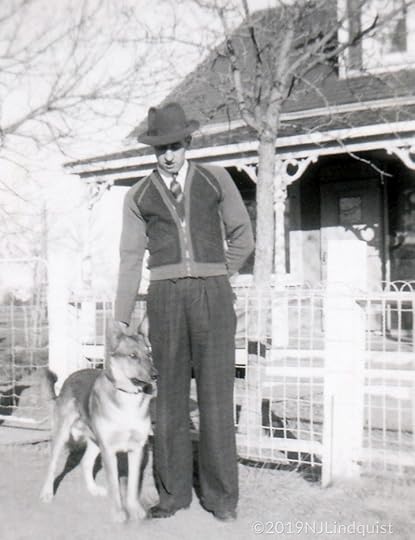
With a large number of young men joining the war effort, jobs were now available that hadn’t been before.
The picture here shows Robert in Indian Head, Saskatchewan, in November of 1939. I’m assuming they were renting a room in the house shown here because they had a number of photos taken outside this house, and I don't believe they could have afforded the rent on a whole house.
From what I recall Mom saying, they moved to Indian Head because Robert found a job opening in the City Meat Market, a busy butcher shop in Indian Head owned by Dave Irwin. Robert's past experience would have more than qualified him for the job and I know it was a very busy place with several men.
Robert Becomes BobIn the last few posts, I've called my dad Robert because that's what his mother and most of his family members called him. However, Margaret, his friends, and a few of his siblings called him Bob. So, after they moved to Indian Head, he was rarely called anything but Bob.
A New Family Member ArrivesWhile I’m sure Bob’s family members were unhappy to see him move so far away, by this time, he and Margaret were more than ready to finally be on their own!
However, they seem to have immediately added a German shepherd to their family. The first pictures of them in Indian Head include Bozo. All my dad ever said to me was that they "got him from a man." (I assume his name came with him.) He'd have been just under a year old at the time.
They must have bought their Kodak Brownie camera shortly after they moved because they began to have more pictures.
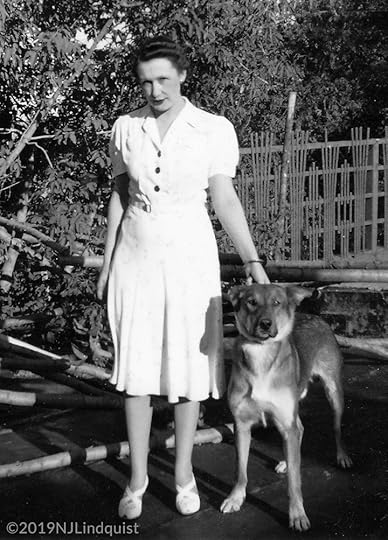 Margaret's family
Margaret's familyBob and Margaret must have visited Rossburn and Yorkton (which would be on the way) in the spring or fall of 1940 because there are a number of photos from that year. I'm wondering if Margaret's brother Hughie got married then, but I don't know the date for sure.
In any case, Hughie and his wife Oral (who was also from Rossburn) were living in Yorkton. The two top pictures were taken in Rossburn and the bottom two in Yorkton, in the back yard of the place where Hughie and Oral were living.
I'm assuming they would have travelled by train unless Bob was able to borrow a car. They didn't own one at this time.
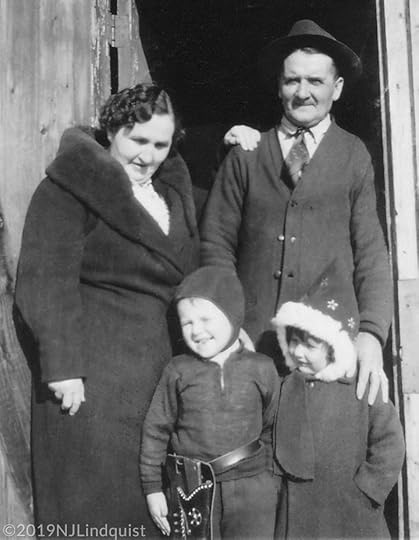
Margaret's parents Alice and Bruce MacDonald, and her youngest brother and sister, Terry and Fay
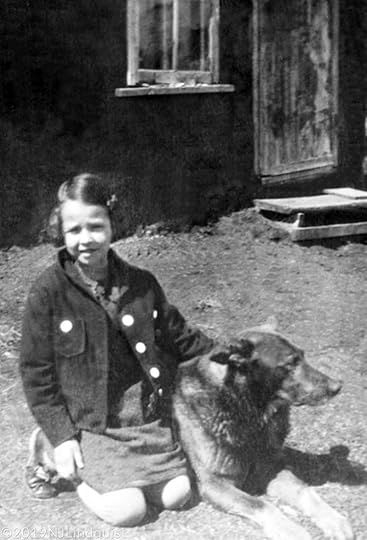
Margaret's sister Brucie with Bozo
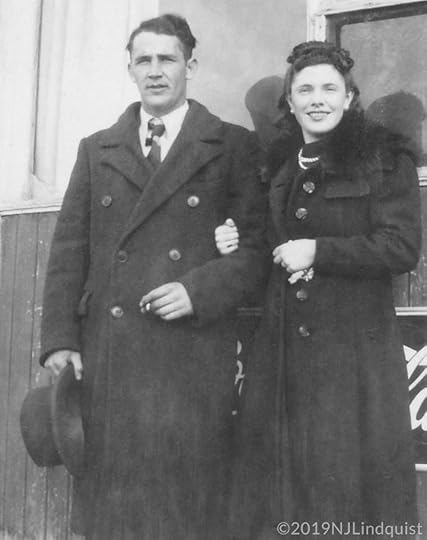
Margaret's brother Hughie and his wife Oral
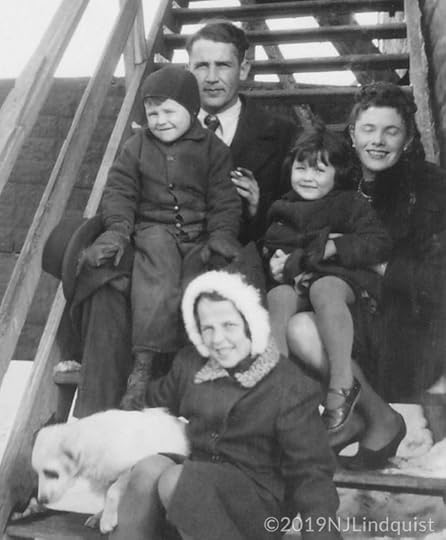
Hughie and Oral with Terry, Fay, Brucie, and their dog, Fluffy.
The Church and CommunityThe next thing I know for sure is that on April 6, 1941, Bob and Margaret officially became members of the United Church in Indian Head.
Note that he is Mr. Robert Shaw and she is Mrs. Robert Shaw. Sigh.
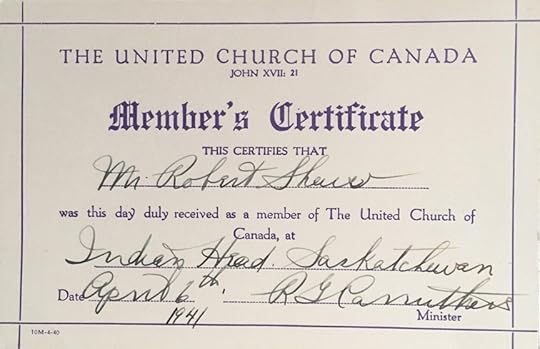
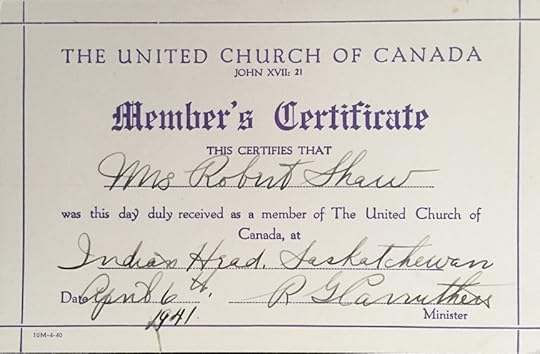
I assume that becoming members of the church meant that Bob and Margaret had decided they wanted to stay in Indian Head. Which makes sense, because they'd met and become friends with a number of people from the community. Since attending a church on Sunday mornings was the norm for many people in those days, they may well have met a lot of their friends through the church.
Some of the people they met there became lifelong friends. Cliff and Grace Horseman, Frank and Myrtle Douglas, Evelyn and Harvey Krug, Otis and Marg Holden, and Jack and Isabel MacDougall, and Mrs. MacDougall (I assume she was Jack's mother) are a few of the people whose names I still remember.
An Unexpected DeathOn July 24, 1941, Margaret’s dad, Bruce MacDonald, became ill and died after nine days in a hospital in Russell, Manitoba. He was only 55.
I was never sure what had caused his death—Mom seemed to think it was pneumonia or a heart attack—so a few years ago, I paid for a copy of the death certificate. The cause of death was listed as peritonitis caused by a perforated duodenal ulcer complicated by organic heart disease. The doctors had operated to try to deal with the ulcer, but to no avail.
The photo near the top of the page is the last one Margaret took of her dad.
Margaret was devastated by her father’s untimely death. Over the years, she often spoke of him, and it was clear to me that she and her dad had been close. His death was one of the saddest times in her life.
Bob went to Rossburn for the funeral with her, and left Margaret with her family for two weeks while he went back to Indian Head to work.
Her mother, Alice, who was still in her mid-forties, was left with three children aged 11, 7, and 5. I'm guessing that Alice's sisters, as well as her older sons (Jim, Mervin, and Hughie), would have helped out financially, and Bob and Margaret would also have helped if they were able.
A Major ChangeThe next picture I have shows Margaret and Bob standing in a doorway which I assume led to an apartment above a store. The photos are dated May, 1942.
From a letter Jennie Shaw, Bob's mother, wrote to a relative in Ireland in 1948, it's apparent that Bob managed to open his own butcher shop in Indian Head. I'm assuming these pictures were taken on the day that happened.
Bob might have rented the store space and the apartment above, but I'm guessing he bought the building. In spite of his lack of education and introversion, he had a surprising ability to make friends with bank managers and other influential people. So I expect he could have convinced someone to give him a mortgage if he could manage the downpayment.
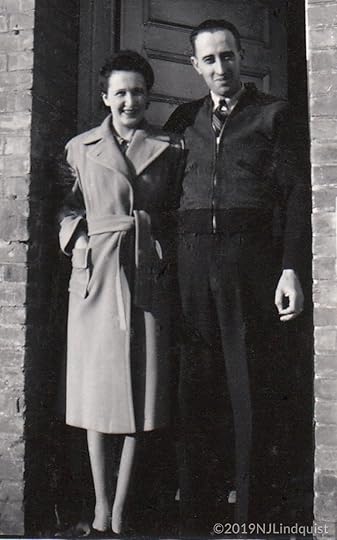
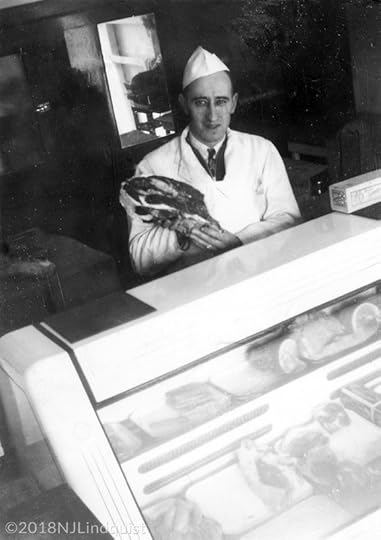
Bob behind the counter in his butcher shop.
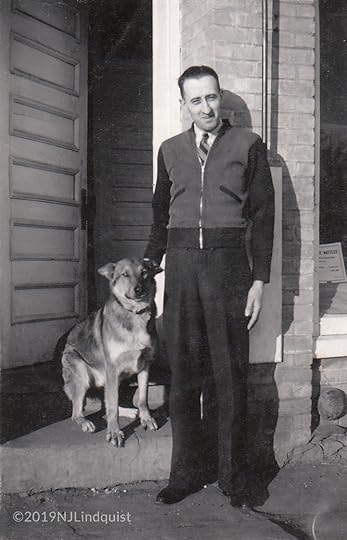
Of course, Bozo was there, too.
I examined some of the older buildings on Grand Avenue in Indian Head a few years ago, and found several that could be the building pictured here. Each had brick walls with stores on the ground level and inset doors leading to apartments on the second stories.
From the smiles on their faces in the picture above, it’s apparent that Bob and Margaret were very happy.
In 1942, Margaret would have been 31 and Bob 30. My guess—and this is only a guess—is that up to the time these pictures were taken, they were eager to start a family but not quite ready. The fact that Bob now had his own business, and presumably a certain measure of security, would have given them that extra bit of assurance that they could manage.
Unfortunately, while some things went well for them, starting a family did not. Not only did Margaret not get pregnant, but she began to have serious health issues.
To be continued next week.
Can You Relate?
Like Bob and Margaret, I expect most of us start out a new venture with certain expectations and a hope that all will go well. But, for many, there's a bump in the road. Or maybe a sharp detour. Can you think of anything in your life or your ancestors' lives that was an unexpected bump in the road with life-changing consequences?
@media (min-width: 300px){.thrv_symbol_10531 [data-css="tve-u-1656479a734"] { width: 100px; float: none; margin-left: auto !important; margin-right: auto !important; margin-top: 0px !important; border: 1px solid rgb(0, 0, 0); box-shadow: rgba(0, 0, 0, 0.4) 0px 8px 12px 0px; }.thrv_symbol_10531 [data-css="tve-u-1656479a731"] { margin-left: 9px !important; }.thrv_symbol_10531 [data-css="tve-u-1656479a730"] { max-width: 57.4%; }.thrv_symbol_10531 [data-css="tve-u-1656479a733"] { max-width: 42.6%; }.thrv_symbol_10531 [data-css="tve-u-1656479a72f"] { max-width: 820px; float: none; width: 100%; margin-left: auto !important; margin-right: auto !important; }.thrv_symbol_10531 [data-css="tve-u-1656479a72e"] { min-height: 245px; }:not(#tve) .thrv_symbol_10531 [data-css="tve-u-1656479a734"] { width: 252px; }:not(#tve) .thrv_symbol_10531 [data-css="tve-u-1656d159d04"] { font-size: 18px !important; }:not(#tve) .thrv_symbol_10531 [data-css="tve-u-1656d159d06"] { font-size: 18px !important; }:not(#tve) .thrv_symbol_10531 [data-css="tve-u-1656d15d51d"] { max-width: 679px; float: none; width: 100%; margin-left: auto !important; margin-right: auto !important; }:not(#tve) .thrv_symbol_10531 [data-css="tve-u-1656d15d51d"] > .tve-cb { justify-content: center; display: flex; flex-direction: column; }:not(#tve) .thrv_symbol_10531 [data-css="tve-u-1656d16fbe9"] { float: none; width: 100%; margin-left: auto !important; margin-right: auto !important; }:not(#tve) .thrv_symbol_10531 [data-css="tve-u-1656d1795e1"] { font-size: 18px !important; line-height: 0.35em !important; }:not(#tve) .thrv_symbol_10531 [data-css="tve-u-1656d17bf7c"] { line-height: 0.6em !important; color: rgb(113, 30, 30) !important; }}
LoveChild: Life Lessons from an Ugly Duckling is the story of my struggle to adjust to the life I was given, and my eventual discovery that, not only had I become a swan but, contrary to my perceptions, I had always been one. Though I didn't realize it until many years later, my life was part of a much bigger plan that all made perfect sense.
I'll be blogging my story once a week.
Find links to all these blogs at:
https://www.njlindquist.com/lovechild/
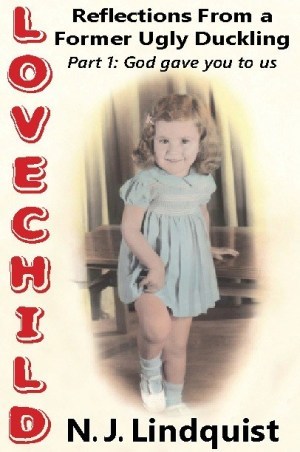
@media (min-width: 300px){.thrv_symbol_10531 [data-css="tve-u-1656479a734"] { width: 277px; float: none; margin-left: auto !important; margin-right: auto !important; margin-top: 0px !important; }.thrv_symbol_10531 [data-css="tve-u-1656479a731"] { margin-left: 9px !important; }.thrv_symbol_10531 [data-css="tve-u-1656479a730"] { max-width: 57.4%; }.thrv_symbol_10531 [data-css="tve-u-1656479a733"] { max-width: 42.6%; }.thrv_symbol_10531 [data-css="tve-u-1656479a72f"] { max-width: 820px; float: none; width: 100%; margin-left: auto !important; margin-right: auto !important; }.thrv_symbol_10531 [data-css="tve-u-1656479a72e"] { min-height: 245px; }:not(#tve) .thrv_symbol_10677 [data-css="tve-u-1656479a734"] { width: 252px; }:not(#tve) .thrv_symbol_10677 [data-css="tve-u-1656d159d04"] { font-size: 18px !important; }:not(#tve) .thrv_symbol_10677 [data-css="tve-u-1656d159d06"] { font-size: 18px !important; }:not(#tve) .thrv_symbol_10677 [data-css="tve-u-1656d15d51d"] { max-width: 679px; float: none; width: 100%; margin-left: auto !important; margin-right: auto !important; }:not(#tve) .thrv_symbol_10677 [data-css="tve-u-1656d15d51d"] > .tve-cb { justify-content: center; display: flex; flex-direction: column; }:not(#tve) .thrv_symbol_10677 [data-css="tve-u-1656d16fbe9"] { float: none; width: 100%; margin-left: auto !important; margin-right: auto !important; }:not(#tve) .thrv_symbol_10677 [data-css="tve-u-1656d1795e1"] { font-size: 18px !important; line-height: 0.35em !important; }:not(#tve) .thrv_symbol_10677 [data-css="tve-u-1656d17bf7c"] { line-height: 0.6em !important; color: rgb(113, 30, 30) !important; }:not(#tve) .thrv_symbol_10677 [data-css="tve-u-165876ba63a"] button { background-image: none !important; background-color: rgb(113, 30, 30) !important; }.thrv_symbol_10677 [data-css="tve-u-165876ba639"] { max-width: 515px; float: none; margin-left: auto !important; margin-right: auto !important; }:not(#tve) .thrv_symbol_10677 [data-css="tve-u-16587b55abb"] { font-size: 22px !important; }}
Have my new posts sent directly to your inbox.
Sign Up to Have All My New Posts Sent to Your Inbox
The post LoveChild 19: Beginning a New Life in Indian Head appeared first on N. J. Lindquist.
November 13, 2019
LoveChild 18: Just Married – and Living with His Family!
“Marriage is meant to keep people together, not just when things are good, but particularly when they are not. That’s why we take marriage vows, not wishes."
Ngina Otiende
After meeting Robert only 6 weeks before, Margaret now entered his world—with only a vague idea of how different it was from her own.
The fairy tale romance was NOT followed up with a fairytale honeymoon! Real life in the thirties hit hard and fast. Margaret's family would have gone back to Rossburn that night so Bruce could open his barber shop the next morning (Monday).
Margaret and Robert would have simply gone up to the bedroom on the second floor of the two-storey house on 11th street in Brandon that had been Robert's since the move to Brandon. His mother Jennie, his sister Margaret, and her husband Albert had bedrooms on the main floor. The other two bedrooms on the second floor were rented out, generally for small amounts of money to people in need.
Everyone on the second floor shared the bathroom, but in those days everyone kept a “chamber pot” under the bed in their rooms that they would empty in the morning. Everyone in the house shared the bathtub.
The front room on the main floor, which would have originally been the living room, had been converted into a bed/sitting room for Granny Shaw, and had its own door.
What would have been the dining room served as a combination dining room and living room. The dining table and chairs were in the middle of the floor, with a buffet and a piano on one side and a chesterfield on the other side. Yes, it was very crowded, but it was the gathering place for the family for a good many years.
Next came the kitchen, with its large wood-burning stove, small table with four chairs, and counter with a sink and cupboards.
Past the kitchen, with a door for privacy, was a smaller room that Margaret and Albert made do with as their bedroom. It had a double bed, a small dresser, a closet, a wooden chair, a few pictures, and not much else.
At the left end of the kitchen was a small bathroom with a toilet and sink which was used by guests but also by those who slept on the main floor.
At the far right was a door to the back yard.
Worldy Things vs Spiritual ThingsI found several Grace Livingstone Hill books in our town library when I was in my teens. If you're not familiar with her, she wrote reasonably well-plotted romances where someone (either the female or male protagonist) became a Christian.
I immediately recognized my mother as one of the staple characters in Grace’s books: the poor little city girl whose life had been focused on fashion, fun, and “worldly” things, who (usually because of a man) found herself transported into the middle of a very religious family where she had to struggle to fit in (or not, as in Margaret's case.)
Robert’s mother and most of his sisters didn’t wear make-up, had little interest in the latest fashions, didn’t dance, didn’t play cards, didn’t believe women should smoke, didn’t believe women should drink alcohol (except a little brandy occasionally for one’s health), and believed it was a woman’s primary role in life to make a good home for her husband and family.
Now don’t get me wrong; I’m not at all saying they weren’t interested in looking good or having nice clothes. But their appearance wasn’t a primary focus, and they thought an excess of focus on appearance was unbiblical and therefore wrong. This was 1937 and many of their beliefs were quite normal at that time, particularly in the evangelical community.
Margaret, on the other hand, had lived in the heady city of Winnipeg since she was 16. She’d been relatively independent, making her own money and paying her way as a boarder in one of her aunt's homes. She knew nothing at all about cooking, keeping house, or looking after a husband. She loved fashion and make-up. She loved dancing and parties, keeping up with current events, knowing the latest gossip. She smoked and drank, although not to excess.
Margaret went to a Presbyterian church, but not regularly. And she thought Robert's mother and his families' obsession with God and the church was at best old-fashioned and certainly not something she wanted to adopt.
The best way I can show this difference is by putting the photo of Jennie Shaw and her daughters (from left, Grace, Jean, Granny Shaw, Sarah, Agnes, and Margaret) next to one of Margaret and Robert.
Both pictures were taken about the time of Margaret and Robert’s wedding. Margaret had insisted they have a proper picture taken because of her dislike of their wedding picture. This was the one that she referred to as their wedding picture, and it was framed and set out in their living room for many years.
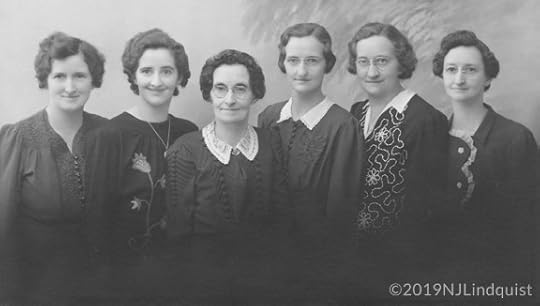
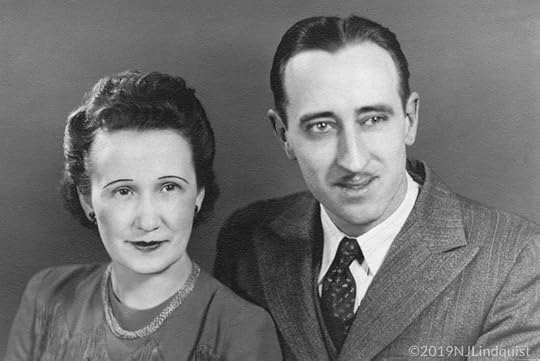
Although Margaret never accepted Robert's mother and most of his sisters way of life, she learned to fit in rather than to argue or provoke them. She never drank or smoked in front of them. She toned down her make-up, too. Of course, she and Robert had very little money, so there wasn’t a lot of temptation to buy things they’d disapprove of.
Fortunately, her sister-in-law Jean also had an interest in fashion, wore make-up, and smoked, so Margaret had one ally. But Jean didn’t wear much make-up or smoke in front of her mother, either.
Robert was perfectly happy with the way Margaret looked, and he didn’t have a problem with her smoking, drinking, or dancing since he did them all himself. So they continued to go out together and have a good time when they could. But in the house, they tried not to tax Jennie Shaw’s and Margaret and Albert’s sensibilities too much.
Of course, Robert's mother and sister were also worried about his relationship with God and his marriage to someone who was quite literally from a different world.
In addition to expecting them to attend church, Jennie gave them a family Bible in which Margaret recorded births and deaths over the years. Whether Robert or Margaret ever read it is doubtful. Except for a few pages at the end of the Old Testament showing births and deaths, the rest of the book looks like new.
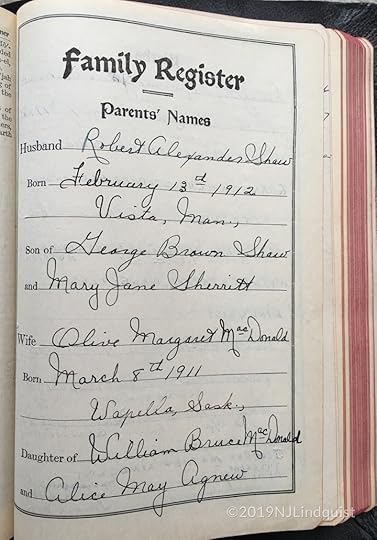
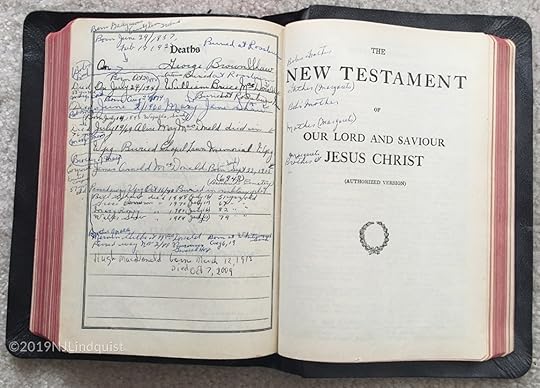
Jennie also gave them a number of small tracts over the years, although again I don't know that anyone read them. Well, except me. I read them out of curiosity when I found them. And I think I still have a few but I'll have to keep searching for them. Several were small red booklets about two inches wide and maybe a bit longer. All of them had Bible verses on a theme and, at the back, information on how to become a Christian.
Looking After RobertRobert's mother immediately realized that Robert’s new “city-girl” wife needed lessons in how to look after a house and cook, so she rolled up her sleeves and went to work.
In later years, Margaret was always embarrassed that she’d had to learn to cook from her mother-in-law. When I questioned her about that—she was the oldest of seven, after all, and the three siblings closest to her age were all boys—she said her own mother always had all her housework done early in the morning, and didn’t encourage much help from her children because she could do it better and faster by herself.
Plus, I know that their living quarters were always small, so I’m guessing it was easier for her to do her work without someone else in the room getting in the way.
So, between them, Jennie Shaw, now 64, and her daughter Margaret Roney (yes, having two Margaret's in the house must have been super annoying!) taught the bride how to cook the food Robert liked, how to wash and iron his shirts, how to polish his shoes, how to shop, and how to manage a household.
By the way, we're talking about cooking on a wood stove. And using a wringer washing machine that was kept in the basement. Drying things on a line in the back yard. And ironing almost everything, including the dish towels and cotton or flannel sheets and pillow cases!
Margaret told me more than once that Robert was spoiled by his mother and sisters. In her words, "Everything had to be the way Robert liked it." She thought it was mostly because of his being the youngest boy, and a little because of his fragility as a baby. It occurs to me now that there might have been a third factor. I think they felt bad for him because of his frustrating struggles in school, which contrasted with his desire to better himself and his strong work ethic. I think they felt he deserved to have as much go his way as possible. Or maybe they just liked him!
In any case, his mother and sister did all they could to make sure Robert’s wife would be able to pull her weight and look after him properly. And gradually, Margaret learned how to cook meals and bake, although she never liked doing either. She learned to clean and keep house, although she never liked doing that either. The good thing was that she did like having everything neat and tidy, and she wanted to learn.
(By the way, I later copied many of Jennie's recipes. Her butter tarts are the best I've ever tasted; same with her pumpkin pie and her salad dressing. Her grape salad is now a family tradition for every holiday. We made her pickles for years. I'm sure there are more recipes we've forgotten came from her.)
Robert Becomes IllLess than a year after their marriage, just after Christmas, 1939, Robert became sick and eventually had to stop going to work at the butcher shop. It began with a cold, then a cough, a headache, chest pains, a then a fever.
Margaret hated Robert’s job as a butcher, and she blamed his getting sick on the coldness of the freezer and the hard work involved in lifting and cutting the heavy sides of beef and pork.
Despite his wife’s concern and his mother’s and sister’s ministrations of mustard plasters, mentholatum, and the other home remedies they knew, Robert’s condition grew worse.
As he lay in bed suffering from a high fever, sweating, severe chills, and constant coughing, they called in a doctor, who examined him and then said the word they’d been dreading. Pneumonia.
At this time, pneumonia was one of the leading causes of death. While penicillin had been discovered ten years earlier, it would be a few more years before it became readily available.
A description of the course of pneumonia at that time:
The typical picture of a patient is a man about 30 years of age, who, after a cold in the head lasting 3 or 4 days is suddenly taken with a shaking chill and stabbing pain in the side of the chest…Fever and malaise continue day after day and prostration progresses. After four or five days, the patient who has become irritable and peevish begins to ‘see things’…After eight or nine days the temperature falls following a drenching sweat. The patient then convalesces over several weeks, unless, after a few days there is an exacerbation of fever with the onset of suppurative complication. In one of four cases, the breathing becomes more labored and shallow…There are periods of apnea increasing in length until breathing ceases.” [3, p. 36–7].
A description of the change in temperature:
“It is usually stated that the temperature continues high without intermission until it breaks on the eighth or ninth day by crisis or gradually descends day by day (lysis)…The duration of temperature in pneumonia varies considerably…with the mode (for the day of temperature termination) on the eighth or ninth day.Margaret was convinced Robert was going to die.
She had to bow to his mother's extensive knowledge of how to nurse a sick patient, but did everything Jennie told her to do. There was a constant stream of mustard plasters, chicken broth, tea, and other home remedies.
They brought a basin of hot water with a little mentholatum in it up to his bedroom and Robert was propped up with a towel over his head so he could breath in the mist and hopefully loosen the phlegm in his lungs.
Of course, his mother, family members, church members, and friends were praying round the clock that God would spare Robert, but the days went by and he didn’t seem any better.
Then, when they had almost given up hope, his fever broke.
He was left very weak. Already thin, he'd lost a lot of weight. His recovery took several months.
He was also left with a life-time reminder of his battle. He had lost his hearing in one ear.
Margaret was adamant that Robert wasn't going to work in the butcher shop any more. As his health got better, he tried other jobs, including selling insurance, but none of them really excited him or made him much money.
The Second World War BeginsThe Second World War began on 1 September 1939 when Germany invaded Poland. Britain and France declared war on Germany on September 3rd. Canada followed suit on September 10, 1939.
Many men rushed to join the army, but because of his deafness in one ear, Robert was ineligible.
On the one hand, I think he was glad not to have to go and fight. On the other, I think he always felt guilty. He later became a member of the Royal Canadian Legion and was always very supportive of those who had been soldiers.
A New BeginningBecause of the many men leaving their jobs to become soldiers, jobs opened up.
In November, 1939, Robert and Margaret left Brandon for Indian Head, Saskatchewan where Robert once more went to work in a butcher shop. After a year and a half of living with Robert's family, they were finally going to be on their own.
Can You Relate?
I wish I'd asked more questions when my parents were around. Instead, I'm trying to connect together bits and pieces.
Do you know what how your parents (or grandparents) got together? Have you asked them?
@media (min-width: 300px){.thrv_symbol_10531 [data-css="tve-u-1656479a734"] { width: 100px; float: none; margin-left: auto !important; margin-right: auto !important; margin-top: 0px !important; border: 1px solid rgb(0, 0, 0); box-shadow: rgba(0, 0, 0, 0.4) 0px 8px 12px 0px; }.thrv_symbol_10531 [data-css="tve-u-1656479a731"] { margin-left: 9px !important; }.thrv_symbol_10531 [data-css="tve-u-1656479a730"] { max-width: 57.4%; }.thrv_symbol_10531 [data-css="tve-u-1656479a733"] { max-width: 42.6%; }.thrv_symbol_10531 [data-css="tve-u-1656479a72f"] { max-width: 820px; float: none; width: 100%; margin-left: auto !important; margin-right: auto !important; }.thrv_symbol_10531 [data-css="tve-u-1656479a72e"] { min-height: 245px; }:not(#tve) .thrv_symbol_10531 [data-css="tve-u-1656479a734"] { width: 252px; }:not(#tve) .thrv_symbol_10531 [data-css="tve-u-1656d159d04"] { font-size: 18px !important; }:not(#tve) .thrv_symbol_10531 [data-css="tve-u-1656d159d06"] { font-size: 18px !important; }:not(#tve) .thrv_symbol_10531 [data-css="tve-u-1656d15d51d"] { max-width: 679px; float: none; width: 100%; margin-left: auto !important; margin-right: auto !important; }:not(#tve) .thrv_symbol_10531 [data-css="tve-u-1656d15d51d"] > .tve-cb { justify-content: center; display: flex; flex-direction: column; }:not(#tve) .thrv_symbol_10531 [data-css="tve-u-1656d16fbe9"] { float: none; width: 100%; margin-left: auto !important; margin-right: auto !important; }:not(#tve) .thrv_symbol_10531 [data-css="tve-u-1656d1795e1"] { font-size: 18px !important; line-height: 0.35em !important; }:not(#tve) .thrv_symbol_10531 [data-css="tve-u-1656d17bf7c"] { line-height: 0.6em !important; color: rgb(113, 30, 30) !important; }}
LoveChild: Life Lessons from an Ugly Duckling is the story of my struggle to adjust to the life I was given, and my eventual discovery that, not only had I become a swan but, contrary to my perceptions, I had always been one. Though I didn't realize it until many years later, my life was part of a much bigger plan that all made perfect sense.
I'll be blogging my story once a week.
Find links to all these blogs at:
https://www.njlindquist.com/lovechild/

@media (min-width: 300px){.thrv_symbol_10531 [data-css="tve-u-1656479a734"] { width: 277px; float: none; margin-left: auto !important; margin-right: auto !important; margin-top: 0px !important; }.thrv_symbol_10531 [data-css="tve-u-1656479a731"] { margin-left: 9px !important; }.thrv_symbol_10531 [data-css="tve-u-1656479a730"] { max-width: 57.4%; }.thrv_symbol_10531 [data-css="tve-u-1656479a733"] { max-width: 42.6%; }.thrv_symbol_10531 [data-css="tve-u-1656479a72f"] { max-width: 820px; float: none; width: 100%; margin-left: auto !important; margin-right: auto !important; }.thrv_symbol_10531 [data-css="tve-u-1656479a72e"] { min-height: 245px; }:not(#tve) .thrv_symbol_10677 [data-css="tve-u-1656479a734"] { width: 252px; }:not(#tve) .thrv_symbol_10677 [data-css="tve-u-1656d159d04"] { font-size: 18px !important; }:not(#tve) .thrv_symbol_10677 [data-css="tve-u-1656d159d06"] { font-size: 18px !important; }:not(#tve) .thrv_symbol_10677 [data-css="tve-u-1656d15d51d"] { max-width: 679px; float: none; width: 100%; margin-left: auto !important; margin-right: auto !important; }:not(#tve) .thrv_symbol_10677 [data-css="tve-u-1656d15d51d"] > .tve-cb { justify-content: center; display: flex; flex-direction: column; }:not(#tve) .thrv_symbol_10677 [data-css="tve-u-1656d16fbe9"] { float: none; width: 100%; margin-left: auto !important; margin-right: auto !important; }:not(#tve) .thrv_symbol_10677 [data-css="tve-u-1656d1795e1"] { font-size: 18px !important; line-height: 0.35em !important; }:not(#tve) .thrv_symbol_10677 [data-css="tve-u-1656d17bf7c"] { line-height: 0.6em !important; color: rgb(113, 30, 30) !important; }:not(#tve) .thrv_symbol_10677 [data-css="tve-u-165876ba63a"] button { background-image: none !important; background-color: rgb(113, 30, 30) !important; }.thrv_symbol_10677 [data-css="tve-u-165876ba639"] { max-width: 515px; float: none; margin-left: auto !important; margin-right: auto !important; }:not(#tve) .thrv_symbol_10677 [data-css="tve-u-16587b55abb"] { font-size: 22px !important; }}
Have my new posts sent directly to your inbox.
Sign Up to Have All My New Posts Sent to Your Inbox
The post LoveChild 18: Just Married – and Living with His Family! appeared first on N. J. Lindquist.
November 7, 2019
Lovechild 17: A Fairytale Romance
“Once in a while, right in the middle of an ordinary life, love knocks our doors, enters our lives, & changes it forever. You start believing in dreams, you start making wishes & you start to trust your heart even more! That love holds your hands & makes you feel you are safer than ever; that love makes you believe that nothing can go wrong now; and oh that warm hug, which makes you want to spend your entire life then & there!"
Anamika Mishra, VoiceMates - A Novel
You know the kind of love, right? When the Prince sees Cinderella for the first time.... When the Prince finds Sleeping Beauty and wakes her with a kiss... When the Prince meets Snow White and... You get the picture.
Well, believe it or not, that's pretty well the kind of love my parents had. Although their meeting was a little different and no members of the royal family were involved.
Some time in late 1936 or early 1937, Robert’s younger sister, Jean Shaw, started to date a young man named Jim MacDonald.
Jim's parents and youngest siblings lived in Rossburn, Manitoba, a village about 24 km north of Kelloe, the village where Robert had lived with his mother after Jennie sold the farm. Jim's father was a barber and also owned the town pool hall. Robert was about a year and a half older than Jim, and Jean was four months younger, so it's quite possible they'd met at least casually.
I don't know if Jean was visiting family in the Rossburn area when they met, or if Jim was working in Brandon at the time. But in any case, the two began to date, and things became quite serious. I'm pretty sure that Jean's mother, Jennie, and some of her older brothers and sisters wouldn't have been happy about this.
Pool halls weren't exactly the best place to hang out in those days. They were often filled with smoke, encouraged gambling, and allowed alcohol. And Jim's dad not only owned the pool hall, but the family lived above it. The fact that he was also a barber might have helped, but not much.
Plus, while they considered themselves Presbyterian, Jim's parents weren't even remotely as committed to the church or Christianity itself as the Shaw family, especially Jennie and her late husband.
In the end, Jean broke it off, mainly because of Jim’s drinking. While her brothers might have a drink now and then, Jim went further. When she asked him to stop drinking, or at least slow down, he seemed unwilling or perhaps unable to do so. In the end, after a few months, she moved on.
Almost immediately, she met someone else. And on November 27, 1937, she married Howard Maltby, a 28-year-old from New Brunswick who was working as a salesman.
No one ever told me exactly how it happened, but during the time Jim and Jean were dating, Jim introduced Jean to his sister, Margaret MacDonald, and the two women became friends. Early in April of 1938, Jean introduced her brother, Robert, to Margaret. I'm guessing that Margaret visited Jean in Brandon at the house she and Howard were living in after their marriage and Jean invited Robert to come over. But it's possible that Jean, Howard, and Robert went to Winnipeg for some reason.
Robert was eleven months younger than Margaret, who had been living in Winnipeg and working for Eaton's since she was 16 (almost 12 years). When they met, Margaret had been engaged for seven years to a man named "Tommy." (If I ever heard his last name, I've forgotten it). Tommy's wife was Catholic and although they were separated, she refused to give him a divorce.
A few weeks after Margaret met Robert, she broke off her engagement to Tommy.
Was it love at first sight? Did Robert look like a prince? Did Margaret look like a princess? No idea. Maybe they were the Depression-era version of a prince and princess.
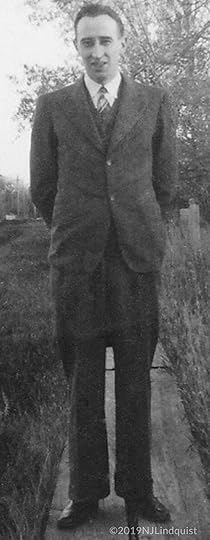
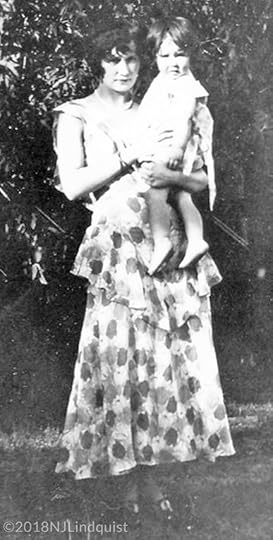 Robert and Margaret had a few things in common.Both came from working class families who had immigrated from the British Isles.Both had fathers who lived great distances from their families.Neither they nor their parents had finished high school.Both liked to dress as well as up-to-date as they could afford.But they also had a lot of differences! Margaret was the eldest of seven while Robert was the second youngest of 12.Margaret's small family had moved a number of times as her dad tried to find better work, and they rarely saw their relatives. Robert had lived in one area all his life, with many family members on his mother's side as well as older brothers and sisters. In fact, some of his best friends were his nephews.Margaret left home at 16 to live in Winnipeg and get a job as a sales clerk. Robert had worked for his family and was now working as a butcher, but he was still living with his mother.Margaret was an extrovert who loved being around other people, and always wanted to be up on what was happening. Robert was a quiet introvert who was a slow reader and had difficulty writing.They do say opposites attract!
Robert and Margaret had a few things in common.Both came from working class families who had immigrated from the British Isles.Both had fathers who lived great distances from their families.Neither they nor their parents had finished high school.Both liked to dress as well as up-to-date as they could afford.But they also had a lot of differences! Margaret was the eldest of seven while Robert was the second youngest of 12.Margaret's small family had moved a number of times as her dad tried to find better work, and they rarely saw their relatives. Robert had lived in one area all his life, with many family members on his mother's side as well as older brothers and sisters. In fact, some of his best friends were his nephews.Margaret left home at 16 to live in Winnipeg and get a job as a sales clerk. Robert had worked for his family and was now working as a butcher, but he was still living with his mother.Margaret was an extrovert who loved being around other people, and always wanted to be up on what was happening. Robert was a quiet introvert who was a slow reader and had difficulty writing.They do say opposites attract!In Margaret, Robert no doubt saw a very attractive, independent, big city girl who dressed in the latest fashions, played tennis, danced, and enjoyed life. She was probably unlike anyone he'd met before.
In Robert, Margaret would have seen a tall, dark, handsome man who dressed as well as he could afford to and was the strong, silent type who would look after her.
Added to that, I think they recognized the same longing in each other. Both had had some hard knocks, but kept going. And they both wanted what others had―a family, a home, and a future that was better than the past. Together, they might make it.
So on May 15, 1938, just six week after they first met, Robert and Margaret were married in Brandon, Manitoba, where Robert lived.
Margaret saved the clipping from the newspaper.
Shaw - MacDonaldThe marriage of Olive Margaret, daughter of Mr. and Mrs. Bruce MacDonald, of Rossburn, and Robert Alexander Shaw, youngest son of Mrs. George B. Shaw, was solemnized in the manse of First United Church on Sunday afternoon, Rev. F. E. H. James officiating. Fourteen were present to witness the ceremony.
The bride was given in marriage by her father and wore a pretty wedding dress of white satin with a wreath of orange blossoms in her hair. The attendants were Mr. and Mrs. Howard Maltby, the latter wearing a frock of pink taffeta with matching accessories. During the signing of the register, Mrs. Albert Roney sang “In the Garden,” the accompanist being W. Johnson.
Following the ceremony, a wedding dinner was served in the home of the groom’s sister, Mrs. Roney. The guests present were Mr. and Mrs. Bruce MacDonald, Fay, Terry and Mervin MacDonald, and W. Johnson, all of Rossburn, Mrs. G. B. Shaw, Mr. and Mrs. Maltby, Mr. and Mrs. Roney, and Miss Lillian Lovatt, of Brandon. Mr. and Mrs. Shaw will reside in the city.
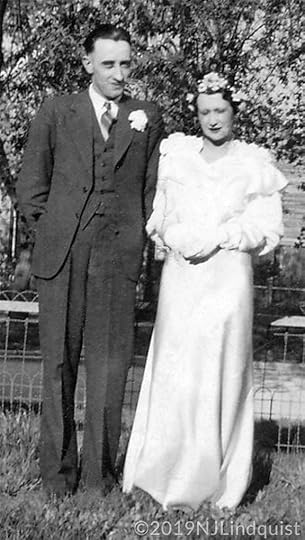
I have no idea whose wedding dress Margaret wore. Unless it was an impulse buy, I assume someone gave or loaned it to her. It definitely isn't something she'd normally have chosen, and I know she didn't like it (especially the wreath in her hair). She never showed anyone the wedding picture.
I find it surprising that Margaret's aunts Maudie and Ettie weren't at the wedding. She'd been boarding with Maudie and Mac for nine years, and was close to Ettie and Bert, too. Her brothers Jim and Hughie weren't there either. Nor was her sister, Brucie. I don't know if they accidentally missed Brucie in the write-up or if she couldn't come for some reason. She'd only have been nine, while Terry was five and Faye three. Margaret's dad never had enough money to buy a car and never learned to drive, so unless her brother Mervin had a car (he'd have been 22), they'd likely have come by train.
Most of Robert sisters and brothers didn't live that far away, but none of them came. In fact, Walter lived right in Brandon, and he and his wife aren't mentioned!
But this was 1938, and the Depression was at its peak, so it might have simply been a lack of money as well as the short notice. Plus, even fourteen people would have been very crowded in the dining room of the Shaw/Roney house where they all went for the wedding dinner.
That house was about to become Margaret's home, too.
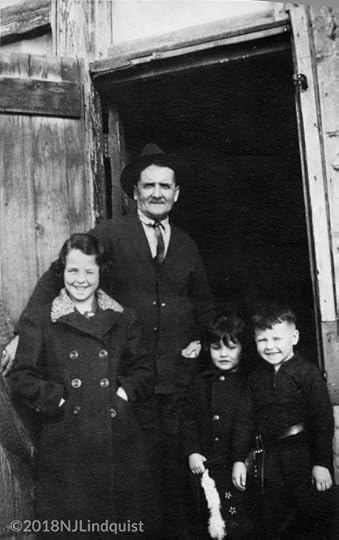
Margaret's dad, Bruce MacDonald, Brucie, Fay, and Terry, at the door near the stairway to their home above the barber shop and pool room.
After the ceremony was over, when the guests were getting ready to leave, her dad told her how embarrassed he was that he’d been unable to buy her a wedding present. He apologized several times, and then said he’d give her all the money he had.
He then reached into his pocket, pulled out a quarter, and handed it to her. At the time, a quarter was the price of a haircut.
Each time Mom told me that story, her eyes filled with tears.
She remembered him as a laughing, cheerful man who was always joking, but it must have been very difficult for him, especially during the depression. He worked long hours as a barber as well as running the pool-hall, yet was barely able to provide more than the basics for his family.
Can You Relate?
I don’t know about you, but my mind kind of boggles at the idea of marrying someone you've known for just six weeks. However, marry they did, and despite massive differences between their backgrounds, personalities, and interests, as well as struggles with things beyond their control, they stayed together for more than 50 years.
Do you have any "Fairytale" stories in your family's history?
Click here if you missed the story of Margaret and her family.
and
Click here if you missed the story of Robert and his family.
@media (min-width: 300px){.thrv_symbol_10531 [data-css="tve-u-1656479a734"] { width: 100px; float: none; margin-left: auto !important; margin-right: auto !important; margin-top: 0px !important; border: 1px solid rgb(0, 0, 0); box-shadow: rgba(0, 0, 0, 0.4) 0px 8px 12px 0px; }.thrv_symbol_10531 [data-css="tve-u-1656479a731"] { margin-left: 9px !important; }.thrv_symbol_10531 [data-css="tve-u-1656479a730"] { max-width: 57.4%; }.thrv_symbol_10531 [data-css="tve-u-1656479a733"] { max-width: 42.6%; }.thrv_symbol_10531 [data-css="tve-u-1656479a72f"] { max-width: 820px; float: none; width: 100%; margin-left: auto !important; margin-right: auto !important; }.thrv_symbol_10531 [data-css="tve-u-1656479a72e"] { min-height: 245px; }:not(#tve) .thrv_symbol_10531 [data-css="tve-u-1656479a734"] { width: 252px; }:not(#tve) .thrv_symbol_10531 [data-css="tve-u-1656d159d04"] { font-size: 18px !important; }:not(#tve) .thrv_symbol_10531 [data-css="tve-u-1656d159d06"] { font-size: 18px !important; }:not(#tve) .thrv_symbol_10531 [data-css="tve-u-1656d15d51d"] { max-width: 679px; float: none; width: 100%; margin-left: auto !important; margin-right: auto !important; }:not(#tve) .thrv_symbol_10531 [data-css="tve-u-1656d15d51d"] > .tve-cb { justify-content: center; display: flex; flex-direction: column; }:not(#tve) .thrv_symbol_10531 [data-css="tve-u-1656d16fbe9"] { float: none; width: 100%; margin-left: auto !important; margin-right: auto !important; }:not(#tve) .thrv_symbol_10531 [data-css="tve-u-1656d1795e1"] { font-size: 18px !important; line-height: 0.35em !important; }:not(#tve) .thrv_symbol_10531 [data-css="tve-u-1656d17bf7c"] { line-height: 0.6em !important; color: rgb(113, 30, 30) !important; }}
LoveChild: Life Lessons from an Ugly Duckling is the story of my struggle to adjust to the life I was given, and my eventual discovery that, not only had I become a swan but, contrary to my perceptions, I had always been one. Though I didn't realize it until many years later, my life was part of a much bigger plan that all made perfect sense.
I'll be blogging my story once a week.
Find links to all these blogs at:
https://www.njlindquist.com/lovechild/

@media (min-width: 300px){.thrv_symbol_10531 [data-css="tve-u-1656479a734"] { width: 277px; float: none; margin-left: auto !important; margin-right: auto !important; margin-top: 0px !important; }.thrv_symbol_10531 [data-css="tve-u-1656479a731"] { margin-left: 9px !important; }.thrv_symbol_10531 [data-css="tve-u-1656479a730"] { max-width: 57.4%; }.thrv_symbol_10531 [data-css="tve-u-1656479a733"] { max-width: 42.6%; }.thrv_symbol_10531 [data-css="tve-u-1656479a72f"] { max-width: 820px; float: none; width: 100%; margin-left: auto !important; margin-right: auto !important; }.thrv_symbol_10531 [data-css="tve-u-1656479a72e"] { min-height: 245px; }:not(#tve) .thrv_symbol_10677 [data-css="tve-u-1656479a734"] { width: 252px; }:not(#tve) .thrv_symbol_10677 [data-css="tve-u-1656d159d04"] { font-size: 18px !important; }:not(#tve) .thrv_symbol_10677 [data-css="tve-u-1656d159d06"] { font-size: 18px !important; }:not(#tve) .thrv_symbol_10677 [data-css="tve-u-1656d15d51d"] { max-width: 679px; float: none; width: 100%; margin-left: auto !important; margin-right: auto !important; }:not(#tve) .thrv_symbol_10677 [data-css="tve-u-1656d15d51d"] > .tve-cb { justify-content: center; display: flex; flex-direction: column; }:not(#tve) .thrv_symbol_10677 [data-css="tve-u-1656d16fbe9"] { float: none; width: 100%; margin-left: auto !important; margin-right: auto !important; }:not(#tve) .thrv_symbol_10677 [data-css="tve-u-1656d1795e1"] { font-size: 18px !important; line-height: 0.35em !important; }:not(#tve) .thrv_symbol_10677 [data-css="tve-u-1656d17bf7c"] { line-height: 0.6em !important; color: rgb(113, 30, 30) !important; }:not(#tve) .thrv_symbol_10677 [data-css="tve-u-165876ba63a"] button { background-image: none !important; background-color: rgb(113, 30, 30) !important; }.thrv_symbol_10677 [data-css="tve-u-165876ba639"] { max-width: 515px; float: none; margin-left: auto !important; margin-right: auto !important; }:not(#tve) .thrv_symbol_10677 [data-css="tve-u-16587b55abb"] { font-size: 22px !important; }}
Have my new posts sent directly to your inbox.
Sign Up to Have All My New Posts Sent to Your Inbox
The post Lovechild 17: A Fairytale Romance appeared first on N. J. Lindquist.
November 6, 2019
LoveChild 17: A Fairytale Romance
“Once in a while, right in the middle of an ordinary life, love knocks our doors, enters our lives, & changes it forever. You start believing in dreams, you start making wishes & you start to trust your heart even more! That love holds your hands & makes you feel you are safer than ever; that love makes you believe that nothing can go wrong now; and oh that warm hug, which makes you want to spend your entire life then & there!"
Anamika Mishra, VoiceMates
- A Novel
You know the kind of love, right? When the Prince sees Cinderella for the first time.... When the Prince finds Sleeping Beauty and wakes her with a kiss... When the Prince meets Snow White and... You get the picture.
Well, believe it or not, that's pretty well the kind of love my parents had. Although their meeting was a little different and no members of the royal family were involved.
Some time in late 1936 or early 1937, Robert’s younger sister, Jean Shaw, started to date a young man named Jim MacDonald.
Jim's parents and youngest siblings lived in Rossburn, Manitoba, a village about 24 km north of Kelloe, the village where Robert had lived with his mother after Jennie sold the farm. Jim's father was a barber and also owned the town pool hall. Robert was about a year and a half older than Jim, and Jean was four months younger, so it's quite possible they'd met at least casually.
I don't know if Jean was visiting family in the Rossburn area when they met, or if Jim was working in Brandon at the time. But in any case, the two began to date, and things became quite serious. I'm pretty sure that Jean's mother, Jennie, and some of her older brothers and sisters wouldn't have been happy about this.
Pool halls weren't exactly the best place to hang out in those days. They were often filled with smoke, encouraged gambling, and allowed alcohol. And Jim's dad not only owned the pool hall, but the family lived above it. The fact that he was also a barber might have helped, but not much.
Plus, while they considered themselves Presbyterian, Jim's parents weren't even remotely as committed to the church or Christianity itself as the Shaw family, especially Jennie and her late husband.
In the end, Jean broke it off, mainly because of Jim’s drinking. While her brothers might have a drink now and then, Jim went further. When she asked him to stop drinking, or at least slow down, he seemed unwilling or perhaps unable to do so. In the end, after a few months, she moved on.
Almost immediately, she met someone else. And on November 27, 1937, she married Howard Maltby, a 28-year-old from New Brunswick who was working as a salesman.
Sounds like the the end of the story? No, it hasn't started yet.
No one ever told me exactly how it happened, but during the time Jim and Jean were dating, Jim introduced Jean to his sister, Margaret MacDonald, and the two women became friends. Early in April of 1938, Jean introduced her brother, Robert, to Margaret. I'm guessing that Margaret visited Jean in Brandon at the house she and Howard were living in after their marriage and Jean invited Robert to come over. But it's possible that Jean, Howard, and Robert went to Winnipeg for some reason.
Robert was eleven months younger than Margaret, who had been living in Winnipeg and working for Eaton's since she was 16 (almost 12 years). When they met, Margaret had been engaged for seven years to a man named "Tommy." (If I ever heard his last name, I've forgotten it). Tommy's wife was Catholic and although they were separated, she refused to give him a divorce.
A few weeks after Margaret met Robert, she broke off her engagement to Tommy.
Was it love at first sight? Did Robert look like a prince? Did Margaret look like a princess? No idea. Maybe they were the Depression-era version of a prince and princess.

Margaret with her youngest sister Fay.

Robert preferred to wear a suit or sports jacket.
Robert and Margaret had a few things in common.
Both came from working class families who had immigrated from the British Isles. Both had fathers who lived great distances from their families. Neither they nor their parents had finished high school. Both liked to dress as well as up-to-date as they could afford.But they had more differences:
Margaret was the eldest of seven while Robert was the second youngest of 12. Margaret's small family had moved a number of times as her dad tried to find better work, and they rarely saw their relatives. Robert had lived in one area all his life, with many family members on his mother's side as well as older brothers and sisters. In fact, some of his best friends were his nephews. Margaret left home at 16 to live in Winnipeg and get a job as a sales clerk. Robert had worked for his family and was now working as a butcher, but he was still living with his mother.Margaret was an extrovert who loved being around other people, and always wanted to be up on what was happening. Robert was a quiet introvert who was a slow reader and had difficulty writing.They do say opposites attract!
In Margaret, Robert no doubt saw a very attractive, independent, big city girl who dressed in the latest fashions, played tennis, danced, and enjoyed life. She was probably unlike anyone he'd met before.
In Robert, Margaret would have seen a tall, dark, handsome man who dressed as well as he could afford to and was the strong, silent type who would look after her.
Added to that, I think they recognized the same longing in each other. Both had had some hard knocks, but kept going. And they both wanted what others had―a family, a home, and a future that was better than the past. Together, they might make it.
So on May 15, 1938, just six week after they first met, Robert and Margaret were married in Brandon, Manitoba, where Robert lived.
Margaret saved the clipping from the newspaper.
Shaw - MacDonald
The marriage of Olive Margaret, daughter of Mr. and Mrs. Bruce MacDonald, of Rossburn, and Robert Alexander Shaw, youngest son of Mrs. George B. Shaw, was solemnized in the manse of First United Church on Sunday afternoon, Rev. F. E. H. James officiating. Fourteen were present to witness the ceremony.
The bride was given in marriage by her father and wore a pretty wedding dress of white satin with a wreath of orange blossoms in her hair. The attendants were Mr. and Mrs. Howard Maltby, the latter wearing a frock of pink taffeta with matching accessories. During the signing of the register, Mrs. Albert Roney sang “In the Garden,” the accompanist being W. Johnson.

Following the ceremony, a wedding dinner was served in the home of the groom’s sister, Mrs. Roney. The guests present were Mr. and Mrs. Bruce MacDonald, Fay, Terry and Mervin MacDonald, and W. Johnson, all of Rossburn, Mrs. G. B. Shaw, Mr. and Mrs. Maltby, Mr. and Mrs. Roney, and Miss Lillian Lovatt, of Brandon. Mr. and Mrs. Shaw will reside in the city.
I have no idea whose wedding dress Margaret wore. Unless it was an impulse buy, I assume someone gave or loaned it to her. It definitely isn't something she'd normally have chosen, and I know she didn't like it (especially the wreath in her hair). She never showed anyone the wedding picture.
I find it surprising that Margaret's aunts Maudie and Ettie weren't at the wedding. She'd been boarding with Maudie and Mac for nine years, and was close to Ettie and Bert, too. Her brothers Jim and Hughie weren't there either. Nor was her sister, Brucie. I don't know if they accidentally missed Brucie in the write-up or if she couldn't come for some reason. She'd only have been nine, while Terry was five and Faye three. Margaret's dad never had enough money to buy a car and never learned to drive, so unless her brother Mervin had a car (he'd have been 22), they'd likely have come by train.
Most of Robert sisters and brothers didn't live that far away, but none of them came. In fact, Walter lived right in Brandon, and he and his wife aren't mentioned!
But this was 1938, and the Depression was at its peak, so it might have simply been a lack of money as well as the short notice.
Even fourteen people would have been very crowded in the dining room of the Shaw/Roney house where they all went for the wedding dinner.
That house was about to become Margaret's home, too.
For Margaret, the most lasting memory from her wedding, a story she told me many times over the years, concerned her father.

Margaret's dad, Bruce MacDonald, Brucie, Fay, and Terry, at the door near the stairway to their home above the barber shop and pool room.
After the ceremony was over, when the guests were getting ready to leave, her dad told her how embarrassed he was that he’d been unable to buy her a wedding present. He apologized several times, and then said he’d give her all the money he had. He then reached into his pocket, pulled out a quarter, and handed it to her. At the time, a quarter was the price of a haircut.
Each time Mom told me that story, her eyes filled with tears.
She remembered him as a laughing, cheerful man who was always joking, but it must have been very difficult for him, especially during the depression. He worked long hours as a barber as well as running the pool-hall, yet was barely able to provide for his family.
Can You Relate?
I don’t know about you, but my mind kind of boggles at the idea of marrying someone you've known for just six weeks. However, marry they did, and despite massive differences between their backgrounds, personalities, and interests, as well as struggles with things beyond their control, they stayed together for more than 50 years.
Do you have any "Fairytale" stories in your families' history?
Click here if you missed the story of Margaret and her family.
and
Click here if you missed the story of Robert and his family.
@media (min-width: 300px){.thrv_symbol_10531 [data-css="tve-u-1656479a734"] { width: 100px; float: none; margin-left: auto !important; margin-right: auto !important; margin-top: 0px !important; border: 1px solid rgb(0, 0, 0); box-shadow: rgba(0, 0, 0, 0.4) 0px 8px 12px 0px; }.thrv_symbol_10531 [data-css="tve-u-1656479a731"] { margin-left: 9px !important; }.thrv_symbol_10531 [data-css="tve-u-1656479a730"] { max-width: 57.4%; }.thrv_symbol_10531 [data-css="tve-u-1656479a733"] { max-width: 42.6%; }.thrv_symbol_10531 [data-css="tve-u-1656479a72f"] { max-width: 820px; float: none; width: 100%; margin-left: auto !important; margin-right: auto !important; }.thrv_symbol_10531 [data-css="tve-u-1656479a72e"] { min-height: 245px; }:not(#tve) .thrv_symbol_10531 [data-css="tve-u-1656479a734"] { width: 252px; }:not(#tve) .thrv_symbol_10531 [data-css="tve-u-1656d159d04"] { font-size: 18px !important; }:not(#tve) .thrv_symbol_10531 [data-css="tve-u-1656d159d06"] { font-size: 18px !important; }:not(#tve) .thrv_symbol_10531 [data-css="tve-u-1656d15d51d"] { max-width: 679px; float: none; width: 100%; margin-left: auto !important; margin-right: auto !important; }:not(#tve) .thrv_symbol_10531 [data-css="tve-u-1656d15d51d"] > .tve-cb { justify-content: center; display: flex; flex-direction: column; }:not(#tve) .thrv_symbol_10531 [data-css="tve-u-1656d16fbe9"] { float: none; width: 100%; margin-left: auto !important; margin-right: auto !important; }:not(#tve) .thrv_symbol_10531 [data-css="tve-u-1656d1795e1"] { font-size: 18px !important; line-height: 0.35em !important; }:not(#tve) .thrv_symbol_10531 [data-css="tve-u-1656d17bf7c"] { line-height: 0.6em !important; color: rgb(113, 30, 30) !important; }}
LoveChild: Life Lessons from an Ugly Duckling is the story of my struggle to adjust to the life I was given, and my eventual discovery that, not only had I become a swan but, contrary to my perceptions, I had always been one. Though I didn't realize it until many years later, my life was part of a much bigger plan that all made perfect sense.
I'll be blogging my story once a week.
Find links to all these blogs at:
https://www.njlindquist.com/lovechild/

@media (min-width: 300px){.thrv_symbol_10531 [data-css="tve-u-1656479a734"] { width: 277px; float: none; margin-left: auto !important; margin-right: auto !important; margin-top: 0px !important; }.thrv_symbol_10531 [data-css="tve-u-1656479a731"] { margin-left: 9px !important; }.thrv_symbol_10531 [data-css="tve-u-1656479a730"] { max-width: 57.4%; }.thrv_symbol_10531 [data-css="tve-u-1656479a733"] { max-width: 42.6%; }.thrv_symbol_10531 [data-css="tve-u-1656479a72f"] { max-width: 820px; float: none; width: 100%; margin-left: auto !important; margin-right: auto !important; }.thrv_symbol_10531 [data-css="tve-u-1656479a72e"] { min-height: 245px; }:not(#tve) .thrv_symbol_10677 [data-css="tve-u-1656479a734"] { width: 252px; }:not(#tve) .thrv_symbol_10677 [data-css="tve-u-1656d159d04"] { font-size: 18px !important; }:not(#tve) .thrv_symbol_10677 [data-css="tve-u-1656d159d06"] { font-size: 18px !important; }:not(#tve) .thrv_symbol_10677 [data-css="tve-u-1656d15d51d"] { max-width: 679px; float: none; width: 100%; margin-left: auto !important; margin-right: auto !important; }:not(#tve) .thrv_symbol_10677 [data-css="tve-u-1656d15d51d"] > .tve-cb { justify-content: center; display: flex; flex-direction: column; }:not(#tve) .thrv_symbol_10677 [data-css="tve-u-1656d16fbe9"] { float: none; width: 100%; margin-left: auto !important; margin-right: auto !important; }:not(#tve) .thrv_symbol_10677 [data-css="tve-u-1656d1795e1"] { font-size: 18px !important; line-height: 0.35em !important; }:not(#tve) .thrv_symbol_10677 [data-css="tve-u-1656d17bf7c"] { line-height: 0.6em !important; color: rgb(113, 30, 30) !important; }:not(#tve) .thrv_symbol_10677 [data-css="tve-u-165876ba63a"] button { background-image: none !important; background-color: rgb(113, 30, 30) !important; }.thrv_symbol_10677 [data-css="tve-u-165876ba639"] { max-width: 515px; float: none; margin-left: auto !important; margin-right: auto !important; }:not(#tve) .thrv_symbol_10677 [data-css="tve-u-16587b55abb"] { font-size: 22px !important; }}
Have my new posts sent directly to your inbox.
Sign Up to Have All My New Posts Sent to Your Inbox
The post LoveChild 17: A Fairytale Romance appeared first on N. J. Lindquist.
October 30, 2019
LoveChild 16: My Father’s Story
“The quality of a father can be seen in the goals, dreams and aspirations he sets not only for himself, but for his family.”
Reed Markham
Robert Alexander Shaw, the fifth son of George and Jennie Shaw, was born on a cold February day in 1912. It was a Tuesday. The 13th. The Birth...
Jennie had a difficult pregnancy, and the baby was premature. Less than two pounds and barely breathing.
The midwife decided that her primary job was to make sure Jennie survived. There were too many other children who needed their mother to worry about a baby who likely wouldn’t make it no matter what she did.
So she quickly wrapped the baby in a blanket and put him in a shoe box, which she then shoved under the bed.
When my mother first told me this story, I thought how heartless the midwife was. But recently I read an amazing story about Martin Couney and his Coney Island Incubators. He charged 25 cents for onlookers to see premature babies lying in incubators he'd imported from France. His reason for doing this was to save the babies. In those days, many doctors in the United States, and I'm going to assume Canada as well, "held the view that premature babies were genetically inferior 'weaklings' whose fate was a matter for God. Without intervention, the vast majority of infants born prematurely were destined to die."
When Robert's father came into the bedroom a little while after the birth, he immediately asked to see the baby. The midwife told him what she'd done. George pulled out the shoe box, and discovered the newborn was still breathing. He quickly called for his daughter Margaret, who was then 13, and made her get into her bed and lie on her back. He then set the baby on Margaret’s chest and carefully covered them both with blankets, using the heat from her body as a natural incubator.
The tiny baby survived, and eventually grew into a six-foot-tall man.
Jennie survived, too. She even gave birth to her 12th baby, Violet Jane (Jean), two years later.
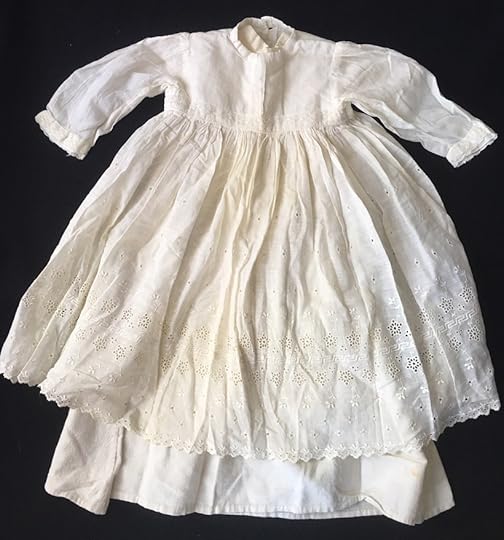
Robert's christening gown was one of the few possessions his mother kept. Whether it was only his or had been used for the other babies, I don't know. All my mother said was that this was his my dad's christening gown. And it is very small. As is the little hat that they would have put on him to take him to and from church in the buggy.
I'm going to include a few pictures of the details. I don't know who made it—likely Jennie or another family member.
It consists of a heavy plain underdress that feels like muslin, and a light cotton overdress that has all kinds of intricate embroidery.
Note: Click on the pictures to make them larger.
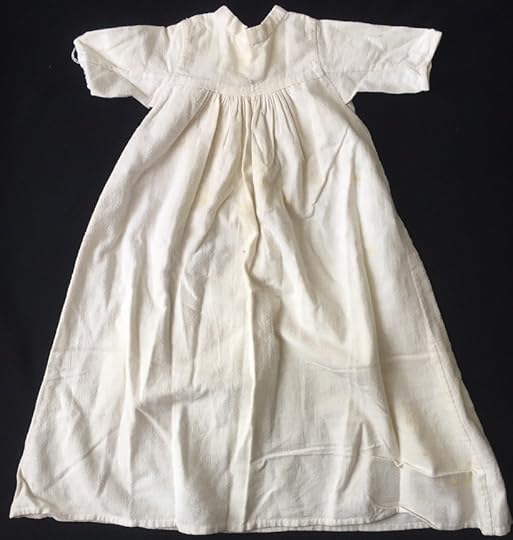
The warm underdress

The cotton skirt has embroidered flowers & leaves
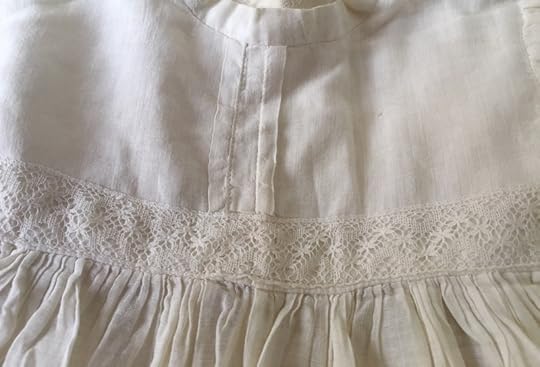
The waist has a delicate lace trim.

The warm cap would fit a small doll. Rabbit fur?
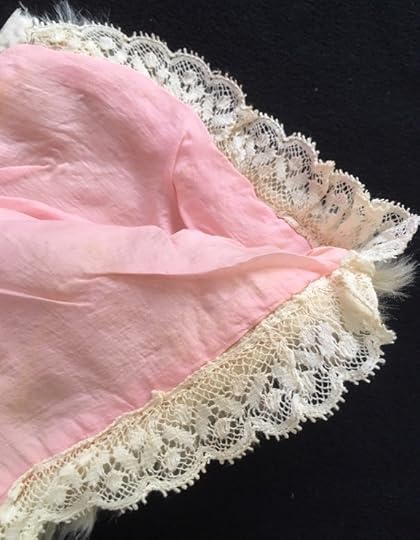
The cap is lined with pink satin? & more lace!
The Young Boy
As was the case with my mother, I have very few pictures of my dad when he was young. Or the other members of his family, for that matter.
This picture of him is taken from the family picture I included in the last post. I'd guess he's about 10 or 11. He looks very sombre, but that's how they all seem to look in formal pictures back then.
But his eyes show he's thinking. Quiet, maybe, and well-behaved right now, but watchful.
He told me his older brothers taught him to smoke “out behind the barn” when he was eight years old.
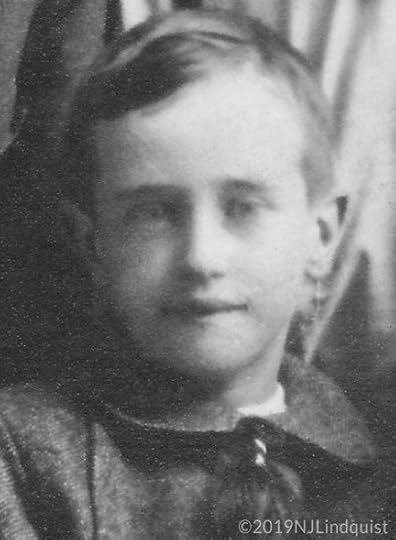
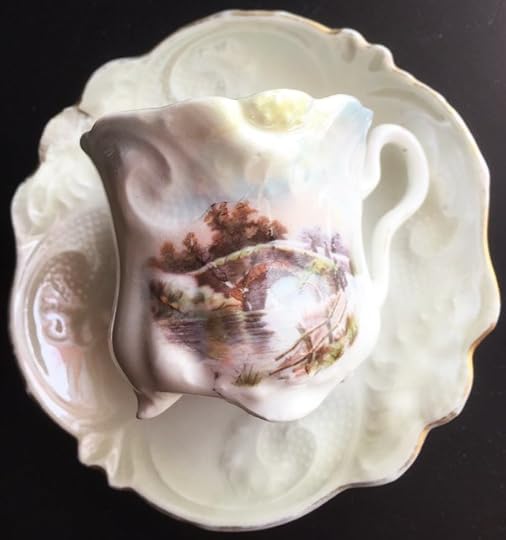
This was my dad's tea cup when he was small. It's very delicate and was made in Genrany. The single yellow part on the rim isn't a flaw, it's part of the scenic picture. The sun?
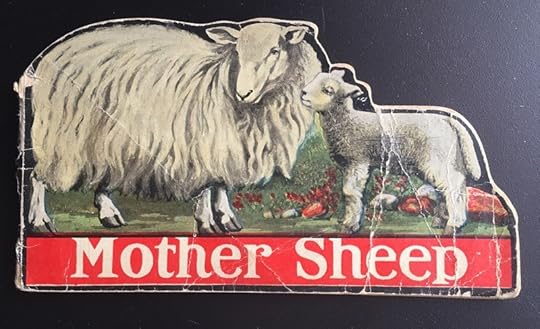
This was my dad's book when he was young. It's a pretty weird story about a mother sheep who had some naughty children—especially one. No idea if he identified with the "black" sheep or not.
The Shaw children, as well as their neighbours, would have gone to a one-room country school, either riding horseback or driving a buggy to get there.
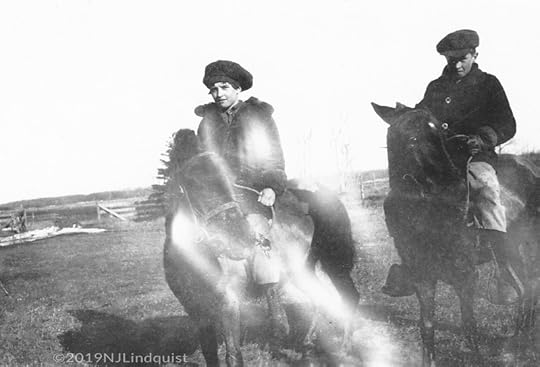
Jean and Robert riding to or from school.
Major ChangesRobert turned 13 just five days before his father’s death on February 18th, 1925.
Jennie was left with a farm to run and four children still at home—Walter (18), Sarah (16), Robert (13), and Jean (11). Fortunately, George Brown Shaw had left them a well-run farm, and with the help of the children still at home, as well as the older ones who still lived in the areas, Jennie kept it going.
Robert didn't like school much, and he'd never done well. Arithmetic wasn't too bad, but he had a lot of difficulty learning to read, and his spelling was terrible. He tried his best, but he found it very frustrating. His teacher, more than once, told him he was "stupid." (I don't know if he had more than one teacher or the same one through elementary school.)
Being a farmer's son, Robert had already been helping on the farm, but while his dad was unwell and after his death, he had to help even more. He was actually happy to leave school after grade eight and work on the farm full-time.
While he learned to read well enough to read the newspaper, Reader's Digest, and the odd Louis L'Amour novel, he read slowly. And he was always embarrassed about writing because he had so much trouble spelling the words.
Flash Forward:
On the evening of October 19, 1989, Robert, who was then 77, was watching the Cosby show. It was the episode in which Theo Cosby was diagnosed with dyselexia.
He became excited. "That's me! That's what I had! The letters at the ends of the words were always changing!"
Of course, when he was in school, no one would have known about dyslexia. But I can't understand why any teacher would call a young boy "stupid."
Fortunately, he didn't let that foolish label make him give up, even though it would have been easy to do. Instead, he spent his life proving it was wrong.
I don't remember ever seeing him as excited as he was that night in the middle of the Cosby show. I believe it was because he finally felt validated. Even though he'd proven it many times over the years, he really wasn't stupid! Nor was he to blame for the difficulties with reading and spelling over the years.
Robert is a young teenager in these pictures.
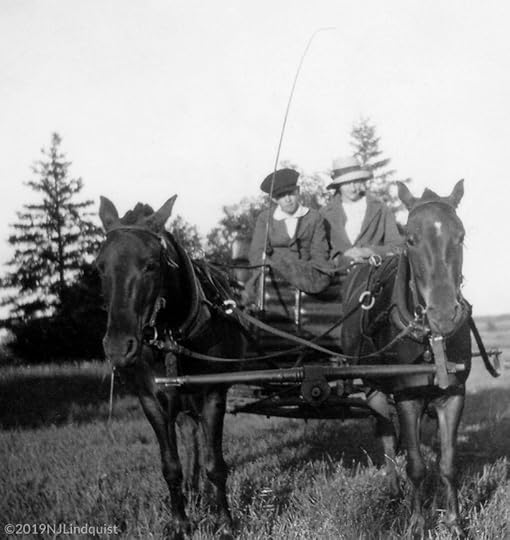
This is Robert, but I'm not sure who he's with. I assume one of his older sisters. Likely Sarah.
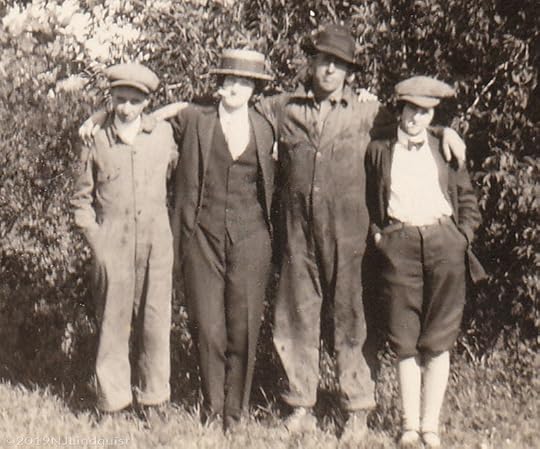
This is Jennie in a man's suit with a corncob pipe. I'm assuming she's with Robert (far left), one of her daughters or a daughter-in-law? (far left), and one of her older sons, either George or Willie. I'm guessing they were going to a costume party? Although the fact that the young woman appears to have a cigarette was something Jennie would have hated, so.... ?
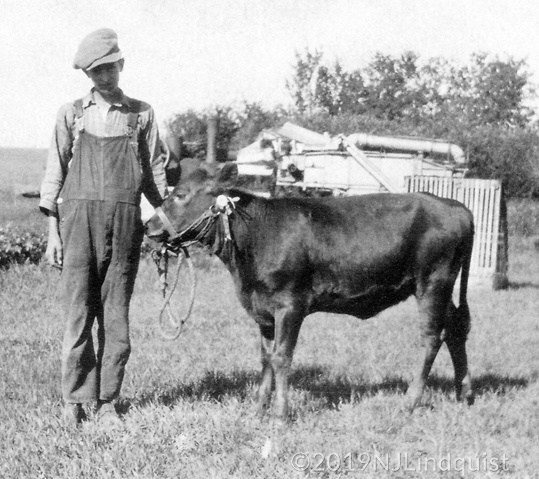
Robert with a calf. Possibly his 4-H calf. There appears to be a ribbon on the bridle. Apparently, 4-H started in Manitoba in 1913. By the way, that looks like a threashing machine for harvesting grain in the background.
Leaving the FarmWalter and Robert had been doing the bulk of the farm work, looking after the animals as well as the crops. But unlike most of their family members, neither of them wanted to be farmers.
On Oct. 14, 1931, Walter, who was then 26, married Marguerte Prior.
Either before or shortly after this, Jennie sold the farm and opened up a boarding house and restaurant in the nearby village of Kelloe, where her parents and a few other family members lived. Jennie and Walter cooked and baked, 24-year-old Sarah cleaned, 19-year-old Robert manned the cash register, and 17-year-old Jean waited on tables.
On Nov. 29, 1933, Sarah married a farmer from the area, Alf Mitchell.
The following year, Jennie's mother died.
Meanwhile, Jennie's daughter Margaret and her husband Albert Roney were having a hard time on their farm near Imperial, Saskatchewan. A grain farm is never secure, and this was the dirty thirties, named so because of the droughts that dried up the soil and the dust storms—winds that blew the soil into the air and away. The financial depression of those years further complicated it because there were no options like "move to the city to get a job." Saskatchewan and Alberta were particularly hard-hit.
Jennie was fortunate to have sold the farm when she did. Margaret and Albert weren't as fortunate, and they needed help.
A Life-Changing MoveBy 1935, Jennie had sold the boarding house and restaurant in Kelloe and bought a house in the city of Brandon, Manitoba, a few blocks from where Walter and his family were living. Jennie, Robert, and Jean shared a two-storey house with Margaret and Albert.
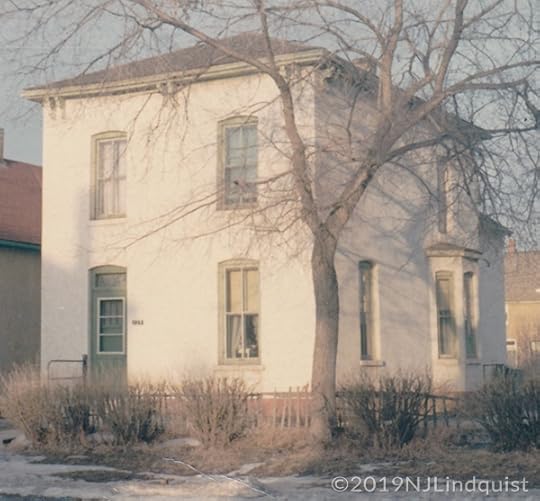
This picture was taken years later, so I don't know if the house always had stucco on the outside, but the inside changed very little. The front and first side windows were in Jennie's room. The bay windows were in the dining room. I think there was a small window above the kitchen sink, but it's hidden by the bay window. By the way, this picture makes the house look a lot wider and bigger than it actually was.
Jennie had what would have been the sitting room at the front, with a door on it. It served as both her sitting room and her bedroom.
Albert and Margaret had a small room that had been added onto the back of kitchen for their bedroom. The tiny kitchen had a very large wood stove that supplied heat for the add-on bedroom. Between the kitchen and Jennie's room was a crowded dining room/living room/music room (Margaret played the piano).
Robert and Jean had their own rooms upstairs, and there was at least one extra room for them to take in a boarder.
Everyone shared the upstairs bathroom and/or used chamber pots.
Albert found a job as a mechanic.
Although it wasn't a job he wanted, Robert found work in a butcher shop. His grade eight education and his continued difficulty reading and writing put a lot of jobs out of his reach. While he didn't like being a butcher, and the actual butchering of the meat was hard work, because of his experience from growing up on a farm that had a lot of animals, he had the needed skills.
A Few Pictures of Robert and His Family in the Early 30s.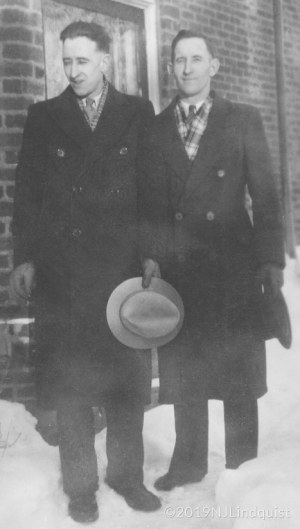
Robert (on left) with his older brother Lawrence. By 1931, Lawrence was living in Michigan, and had married. He became a pastor.
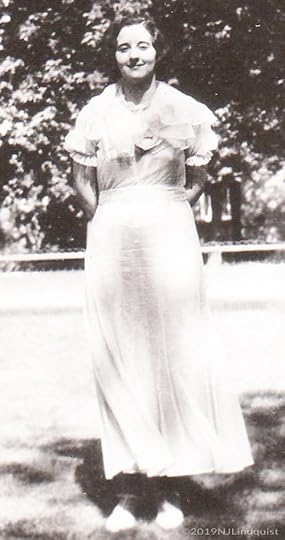
Jean in her early twenties.
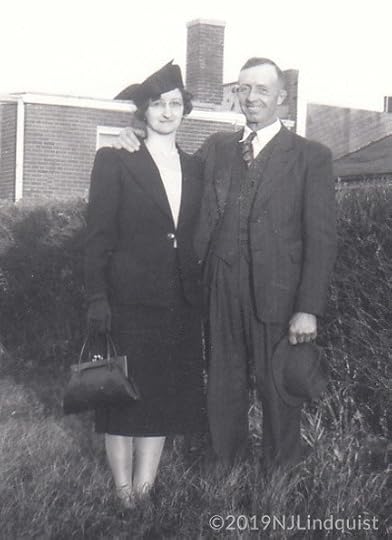
Robert's sister Margaret and her husband Albert Roney.
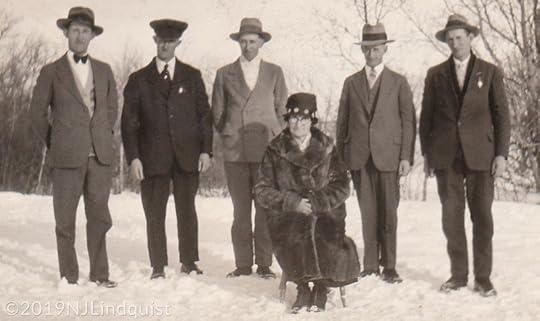
From left (I believe) Lawrence, William (Willie or Bill), Robert, Walter, George. With their mother Jennie. Both William and George seem to be wearing medals, and I think they were both served in some way in World War I. If you're looking at height, the proportions might be off. Robert was six feet tall, but quite thin, and close to the same height as Lawrence, who looks taller here.

From left, Grace, Jean, Jennie, Sarah, Agnes, Margaret.
There Has to Be MoreSo, by 1935, Jennie and four of her children lived in Brandon, with the rest in the general vicinity of Rossburn. All were married except the two youngest, Robert and Jean, who were 24 and 22.
Although he was the youngest son, and, according to some theories would have been less likely to take on responsibility than an older or only child, in reality Robert was a very responsible person. He came from a line of hard workers, so he never shirked work. But he really didn't want to be a farmer. And he didn't want to work in a butcher shop, either, although at this point he had little choice. I'm sure he must have felt confused and frustrated, wondering what his future held. As did Jean, who hadn't yet found a man she cared for enough to marry, and had no real training for a job other than waiting tables.
What did the future hold for them?
Can You Relate?
Louis L'Amour's cowboy characters, especially the Sacketts, often used the phrase, "I had it to do." I often think of that phrase when I have something I don't want to do, but need to. And then I think of my dad and his parents and their ancestors. They were people who weren't afraid of hard work, didn't take the easy way out, and basically did what they had to do in order to survive.
Can you think of members of your family who had this sort of mentality? Or did they have a different way of looking at things? Sometimes we do the opposite of what our parents did, too. Who or what do you think of when you have something you know you need to do, but don't want to?
See all the LoveChild Memoir posts from 1 to 16.
@media (min-width: 300px){.thrv_symbol_10531 [data-css="tve-u-1656479a734"] { width: 100px; float: none; margin-left: auto !important; margin-right: auto !important; margin-top: 0px !important; border: 1px solid rgb(0, 0, 0); box-shadow: rgba(0, 0, 0, 0.4) 0px 8px 12px 0px; }.thrv_symbol_10531 [data-css="tve-u-1656479a731"] { margin-left: 9px !important; }.thrv_symbol_10531 [data-css="tve-u-1656479a730"] { max-width: 57.4%; }.thrv_symbol_10531 [data-css="tve-u-1656479a733"] { max-width: 42.6%; }.thrv_symbol_10531 [data-css="tve-u-1656479a72f"] { max-width: 820px; float: none; width: 100%; margin-left: auto !important; margin-right: auto !important; }.thrv_symbol_10531 [data-css="tve-u-1656479a72e"] { min-height: 245px; }:not(#tve) .thrv_symbol_10531 [data-css="tve-u-1656479a734"] { width: 252px; }:not(#tve) .thrv_symbol_10531 [data-css="tve-u-1656d159d04"] { font-size: 18px !important; }:not(#tve) .thrv_symbol_10531 [data-css="tve-u-1656d159d06"] { font-size: 18px !important; }:not(#tve) .thrv_symbol_10531 [data-css="tve-u-1656d15d51d"] { max-width: 679px; float: none; width: 100%; margin-left: auto !important; margin-right: auto !important; }:not(#tve) .thrv_symbol_10531 [data-css="tve-u-1656d15d51d"] > .tve-cb { justify-content: center; display: flex; flex-direction: column; }:not(#tve) .thrv_symbol_10531 [data-css="tve-u-1656d16fbe9"] { float: none; width: 100%; margin-left: auto !important; margin-right: auto !important; }:not(#tve) .thrv_symbol_10531 [data-css="tve-u-1656d1795e1"] { font-size: 18px !important; line-height: 0.35em !important; }:not(#tve) .thrv_symbol_10531 [data-css="tve-u-1656d17bf7c"] { line-height: 0.6em !important; color: rgb(113, 30, 30) !important; }}
LoveChild: Life Lessons from an Ugly Duckling is the story of my struggle to adjust to the life I was given, and my eventual discovery that, not only had I become a swan but, contrary to my perceptions, I had always been one. Though I didn't realize it until many years later, my life was part of a much bigger plan that all made perfect sense.
I'll be blogging my story once a week.
Find links to all these blogs at:
https://www.njlindquist.com/lovechild/

@media (min-width: 300px){.thrv_symbol_10531 [data-css="tve-u-1656479a734"] { width: 277px; float: none; margin-left: auto !important; margin-right: auto !important; margin-top: 0px !important; }.thrv_symbol_10531 [data-css="tve-u-1656479a731"] { margin-left: 9px !important; }.thrv_symbol_10531 [data-css="tve-u-1656479a730"] { max-width: 57.4%; }.thrv_symbol_10531 [data-css="tve-u-1656479a733"] { max-width: 42.6%; }.thrv_symbol_10531 [data-css="tve-u-1656479a72f"] { max-width: 820px; float: none; width: 100%; margin-left: auto !important; margin-right: auto !important; }.thrv_symbol_10531 [data-css="tve-u-1656479a72e"] { min-height: 245px; }:not(#tve) .thrv_symbol_10677 [data-css="tve-u-1656479a734"] { width: 252px; }:not(#tve) .thrv_symbol_10677 [data-css="tve-u-1656d159d04"] { font-size: 18px !important; }:not(#tve) .thrv_symbol_10677 [data-css="tve-u-1656d159d06"] { font-size: 18px !important; }:not(#tve) .thrv_symbol_10677 [data-css="tve-u-1656d15d51d"] { max-width: 679px; float: none; width: 100%; margin-left: auto !important; margin-right: auto !important; }:not(#tve) .thrv_symbol_10677 [data-css="tve-u-1656d15d51d"] > .tve-cb { justify-content: center; display: flex; flex-direction: column; }:not(#tve) .thrv_symbol_10677 [data-css="tve-u-1656d16fbe9"] { float: none; width: 100%; margin-left: auto !important; margin-right: auto !important; }:not(#tve) .thrv_symbol_10677 [data-css="tve-u-1656d1795e1"] { font-size: 18px !important; line-height: 0.35em !important; }:not(#tve) .thrv_symbol_10677 [data-css="tve-u-1656d17bf7c"] { line-height: 0.6em !important; color: rgb(113, 30, 30) !important; }:not(#tve) .thrv_symbol_10677 [data-css="tve-u-165876ba63a"] button { background-image: none !important; background-color: rgb(113, 30, 30) !important; }.thrv_symbol_10677 [data-css="tve-u-165876ba639"] { max-width: 515px; float: none; margin-left: auto !important; margin-right: auto !important; }:not(#tve) .thrv_symbol_10677 [data-css="tve-u-16587b55abb"] { font-size: 22px !important; }}
Have my new posts sent directly to your inbox.
Sign Up to Have All My New Posts Sent to Your Inbox
The post LoveChild 16: My Father’s Story appeared first on N. J. Lindquist.
October 23, 2019
LoveChild 15: My Father’s Parents, George and Jennie Shaw
“We’re all immortal, as long as our stories are told.”
― Elizabeth Hunter, The Scribe
George Brown Shaw
George Brown Shaw (presumably named after his mother's father, George Brown) was born in Ballymacarn, Ireland, in 1857. He was the second child and eldest son of Robert and Margaret Shaw. His father was a tenant, leasing his farm from a landlord. (If you missed it, see an earlier post about our Shaw/Brown ancestry.)
While still young (I'm guessing around 14), George was apprenticed to a watchmaker in Belfast, Ireland. He worked there for several years, and worked another year in Glasgow, Scotland. He then emigrated to Canada in 1880 and worked in Mitchell, Ontario (near Stratford). Perhaps as a watchmaker? But he may have also worked on a farm. Perhaps with horses.
George was about 20 when his father died, leaving his mother with five children ages 5 to 15. He returned to Ireland after he learned about his father's death, but in 1883, when George was 26 and his younger brothers were roughly 22 and 16, George again left for Canada, this time to stay. He was able to get a homestead near Birtle, Manitoba (west of Winnipeg).
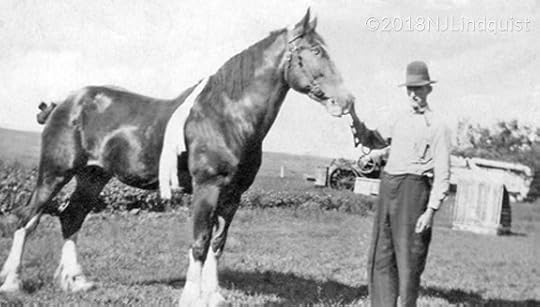
A fairly young George Brown Shaw. Yes, I believe he has a corncob pipe.
The few pictures I have of George show a ramrod straight man. From what my dad and my uncles and aunts told me, I got the impression he was a man of his word, but also fairly strict and someone who expected his children to behave.
He was a good farmer, and was well-respected in the neighbouring community.
Mary Jane (Jennie) Sherritt
George Sherritt and his wife Sarah Jane were both born in Ontario. Their eldest daughter, Mary Jane (Jennie) Sherritt, born in 1874, was therefore a third generation Canadian. Mary Jane would have been about three when her parents began the trek from Huron County, Ontario to Shoal Lake, Manitoba. Her younger sister Ida Jane was less than a year old. (See the two previous Sherritt/Baird Ancestry posts.)
Like George Brown Shaw, Jennie's father eventually homesteaded in the Shoal Lake area, near the village of Silver Creek. But they made a number of stops along the way. They arrived at their homestead in about 1884, possibly around the same time as George Brown Shaw would have arrived at his homestead near the village or Birtle. So it took the Sherritt family roughly seven years to get to their final homestead.
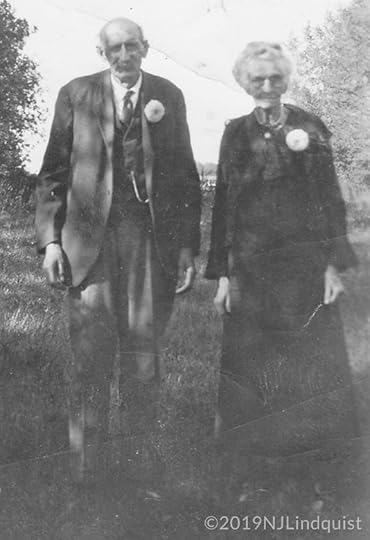
George and Sarah Jane Sherritt in their 80s.
An Unusual Courtship
One of my dad’s cousins told me that George Shaw first met Jennie Sherritt when he was 29 and she was 12, and that George decided then and there that he was going to marry her one day. It's quite possible, because George was farming in the same general area as the Sherritts. Given the dates of arrival in the area, it's even possible that they travelled the last miles to their homesteads together.
I assume that they'd have attended different churches, with the Sherritts being Wesleyan/Methodist and George Shaw being Presbyterian. However, both George Sherritt and George Brown Shaw were loyal members of the Loyal Orange Lodge, so that might have been how they met.
In any case, Jennie turned 16 in June of 1890, and five months later, she married George Brown Shaw, who would then have been about 33—just seven years younger than her father.
As the oldest in her family, Jennie would have been experienced at caring for a family since at that point, she'd had eight younger siblings, including a new baby, by the time she was married. One way to look at it is that she went from helping her mother look after their home and her younger siblings to looking after her own home and children.
Curiously, the 1891 Census lists Jennie as 19 and George as 28. Whether they were confused about their dates of birth, the census taker wrote the ages down wrong, or they didn't want people to know their actual ages, I have no idea. But it is interesting.
Their Family
Jennie was a few weeks short of 17 when she gave birth to her first child, Sarah Jane (after Jennie's mother), at their farm in Birtle, Manitoba. Jennie's mother had given birth to her last child, Stella Maud, just six months earlier.
I can imagine the heartache Jennie and George, as well as Jennie's family, felt a little over seven months later when baby Sarah Jane died.
Eleven months after that, a son, George Andrew, was born.
According to the 1901 Census, between 1893 and 1895, the Shaw family moved to a farm in Shoal Lake. Mary Agnes was born in 1895. Then William (Bill or Willie) (1897), Margaret Ida (1898). (That year, Jennie's 24-year-old brother John died.)
In 1901, Jennie gave birth to twins Lawrence (Lorne) and Violet Jean. Another daughter, Grace, was born in 1903, but unfortunately, one of the twins, Violet, who I believe had always been sickly, died six months later.
In 1905, a little over two years after Grace's birth, Thomas Walter arrived. His birth place is listed as Russell, which is not far from Shoal Lake, so the family may have moved there before his birth. No doubt all their children were born at home, as was common in those days. Likely with another woman (neighbour, family member, or a midwife) in attendance.
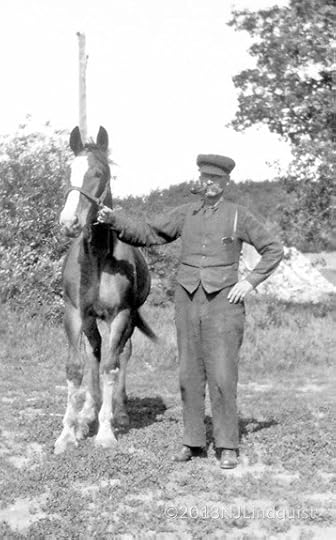
George Brown Shaw with one of his horses.
According to the 1906 Census, George was now 46 (two or three years younger than he actually was) and Jennie was 31. Their children were 12, 10, 8, 6, 4, 2, and 1.
They were also now listed as living at Shoal Lake again, so they had presumably moved from Russell at some point.
In addition to the family, they had two other people living in the house: Hannah Berabosh, age 16, who was listed as German and worked as a domestic servant, no doubt helping Jennie. And Charles Bellamy, age 34, who was Scottish, and was there as a lodger.
The Census asked about animals, and they listed 75 horses, 7 milk cows, 14 head of cattle, and 6 hogs. I'm guessing there were also chickens, and maybe gueese or ducks, but perhaps they didn't count.
A fourth daughter, Sarah Agnes, was born in 1907.
In January of 1910, George made the first payment of $1,902 on a mortgage for a farm south of Rossburn, Manitoba, which he bought from Alexander and Jessie Cummings. My guess is that the total cost was roughly $10,500 spread out over ten years.
I don't know if the farm house was already there or not. Probably.
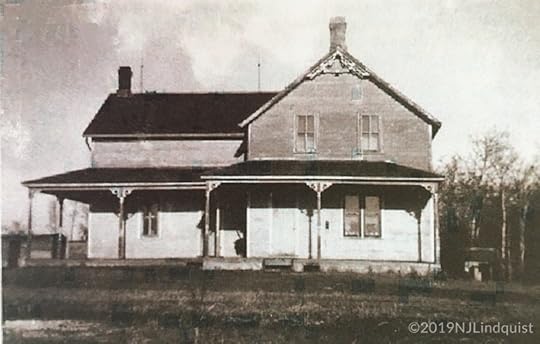
Sidenote: I have the original mortgage for the farm and 12 receipts for payment to Alex Cummings, dated 1910 to 1919. It's unusual in that the money loaned to George for the downpayment actually came from Jessie Cummings, Alex's wife.
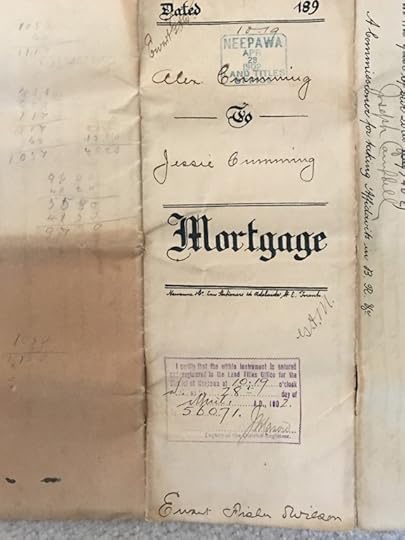
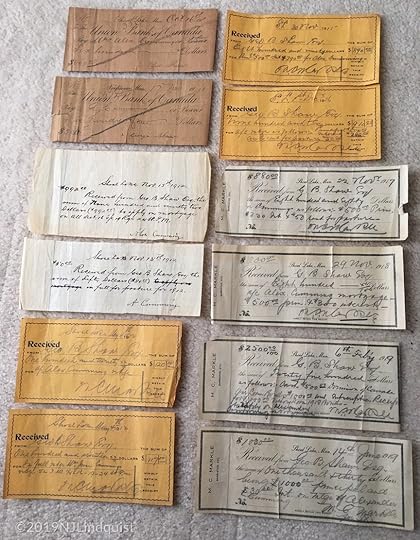
A fifth son, Robert (Bob) Alexander, was born on February 13th, 1912 in the new farmhouse. Two years later, Jennie gave birth for the 12th and last time to a daughter, Violet Jane (Jean). Between the age of almost 17 and 39, she'd given birth to 12 children, roughly one every two years. And if I'm counting correctly, she and George and their children had moved four times.
Other KeepsakesBeing a member of the Orange Lodge was important to George.I have letters transferring George Brown Shaw's membership in the Loyal Order of the Orange Lodge from Ireland to Canada in 1890, and affirming his membership in 1900, 1903, and 1912. If you click on them you can see the larger photos. Basically, they attest to his having regularly received the Degree of a Purple-Blue Royal Arch Purple Marksman. ??
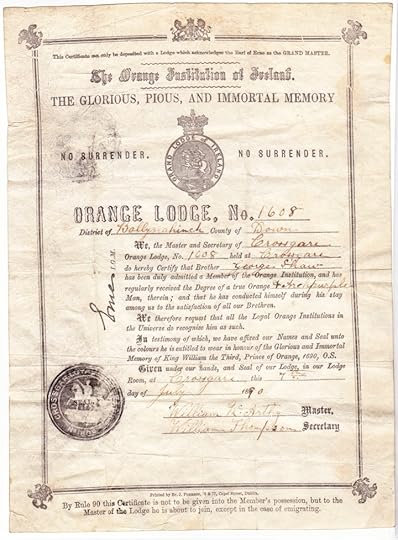
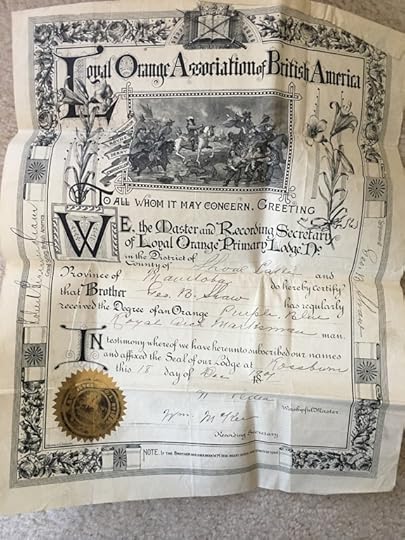
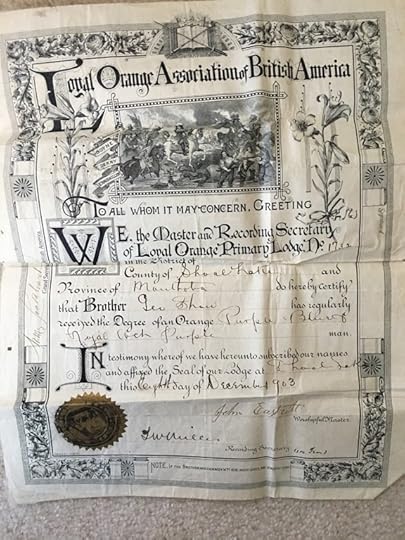
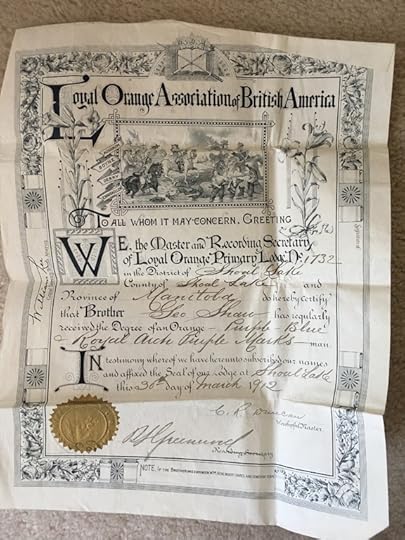
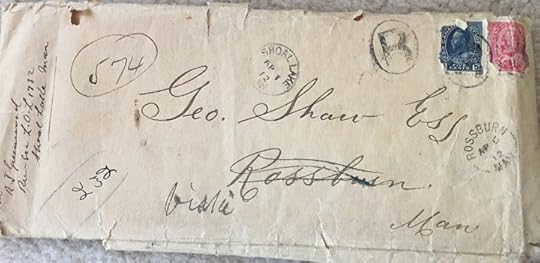
The letter the Orange Lodge certificates were in. I include it here because of the beautiful handwriting!
Two other keepsakes
George's engraved cuff links - maybe connected to the Orange Lodge?
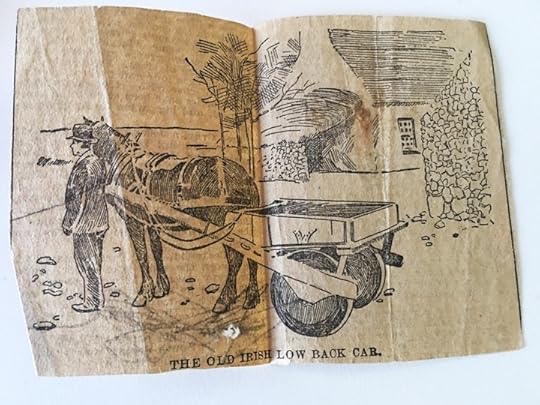
An Irish cartoon? The fact that they saved this is probably a very good reason to think this is how they travelled.
The George Brown Shaw Family
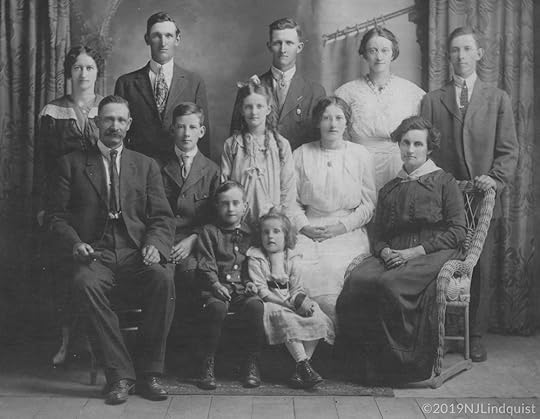
Judging by the ages of the youngest children, this family photo was taken around 1922-24.
Back row from left, Margaret, George, Bill, Agnes, Lorne.
Middle row from left, George, Walter, Sarah, Grace, Jennie.
Front row, Robert and Jean.
It was common to name a child after a child who had died. In this case, both Sarah and Violet were named after siblings who only lived less than two years.
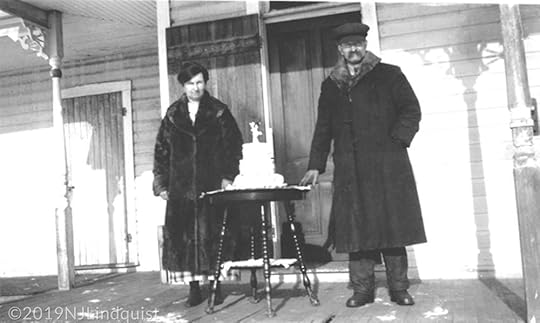
This is the only picture I have of George and Jennie together. The date was January 16th, 1924, and the occasion was their daughter Margaret’s wedding. I assume this is the wedding cake.
Unfortunately, just over a year after the above photo was taken, on February 18th, 1925, George Brown Shaw died. He was 67.
Below, is the obituary from the Rossburn newspaper.
George Brown Shaw is called by death.*
Was Well Known Throughout
Southern Manitoba ...Valued
Citizen of Rossburn District
Rossburn, Manitoba, February 25. A well-known and highly respected citizen of this district passed away last Wednesday evening, when George Brown Shaw died at his home south of town. Mr. Shaw had been sick for almost a year, and his death was not unexpected.
Mr. Shaw was widely known through this central part of the province and was a valued citizen of this community.
The late George Brown Shaw was born at Ballymacarn, County Down, Ireland, in 1857. While still young, he became apprenticed to a watchmaker and spent several years in Ireland and one at Glasgow, Scotland, in that capacity. About 1880 he came to Canada and resided at Mitchell, Ontario for a short time, returning to Ireland again when his father died. He spent a short time with his mother on her farm, and then in 1883 returned to Canada, came to Manitoba and homesteaded near Birtle. Later he moved to Shoal Lake.
His next home was at Russell, but after a short stay there he returned to Shoal Lake. Fourteen years ago he bought a farm south of Rossburn on which he resided until his death. On November 1, 1890, he married Mary Jane (Jennie*) Sherritt, daughter of Mr. and Mrs. Geo. Sherritt, now of Kelloe, Manitoba.
He is survived by a widow and ten children, five boys and five girls. The children are Mrs. I. W. Taylor [Agnes*], Rossburn; Mrs. Laughlin Cameron [Grace*], Kelloe: Mrs. Albert Roney [Margaret*], Imperial, Saskatchewan; George Andrew, Shoal Lake; Lawrence, at Kelloe; William at Rossburn; and Thomas Walter, Robert Alexander, Violet Jane and Sarah at home.
The funeral was conducted on Saturday by Reverend M. E. Nixon. A short service was held in the home at 12:30, after which the funeral cortege proceeded to Rossburn, where a public service was held in the Union Church. The members of the LOL (Loyal Orange Lodge*) attended in a body. Internment was made in Rossburn cemetery.
The late Mr. Shaw was widely known throughout the central part of the province, and was a valued citizen of this community during the period of his residence here.
He is not dead, but sleepeth,
In quiet, peaceful rest.
Jesus his spirit keepeth,
In the mansions of the Blessed.
*This obituary is taken from A History of The Shaw Family of Ballymacarn, published in August, 2008.
*I added a few names, all italicized.
When George died, Jennie was 50 years old, and had four children still at home—Jean (11), Robert (who turned 13 five days before his father’s death), Sarah (16), and Walter (18).
According to my father, the farm had been very well-run, and with the help of her children, both the younger ones and a few of the older ones who had farms nearby, Jennie was able to keep it going.
Robert had already been working on the farm since he was young, but after grade eight, he left school to work full-time with Walter.
Jennie's family was still near-by. When her husband died, her parents were in their mid-70s.
I was looking at the time line, and between the ages of 50 and 67, Jennie lost not only her husband, but her sister, Margaret (age 44); her mother, Sarah Jane (85); her father, George (89); her sister, Stella (54); and her second son, Willie (51). I know Willie's death was a huge blow to her.
But Jennie's story didn't end there and I'll be talking about her more later on.
Can You Relate?
I never met George Brown Shaw, so I can't say much about him. But I did know Jennie in her later years. I knew she'd had a pretty hard life, although I doubt she'd have said so. But thinking about all the responsibility she must have had, from a very early age, and all the travelling and moving they did, starting from when she was only three, makes me think that if anyone epitomizes the word "pioneer" to me, it's Jennie. Or, as I knew her, "Granny Shaw." By the way, her children, even as adults, always addressed her as "Mother."
Do you have a family member who inspires you in some way?
@media (min-width: 300px){.thrv_symbol_10531 [data-css="tve-u-1656479a734"] { width: 277px; float: none; margin-left: auto !important; margin-right: auto !important; margin-top: 0px !important; }.thrv_symbol_10531 [data-css="tve-u-1656479a731"] { margin-left: 9px !important; }.thrv_symbol_10531 [data-css="tve-u-1656479a730"] { max-width: 57.4%; }.thrv_symbol_10531 [data-css="tve-u-1656479a733"] { max-width: 42.6%; }.thrv_symbol_10531 [data-css="tve-u-1656479a72f"] { max-width: 820px; float: none; width: 100%; margin-left: auto !important; margin-right: auto !important; }.thrv_symbol_10531 [data-css="tve-u-1656479a72e"] { min-height: 245px; }:not(#tve) .thrv_symbol_10531 [data-css="tve-u-1656479a734"] { width: 252px; }:not(#tve) .thrv_symbol_10531 [data-css="tve-u-1656d159d04"] { font-size: 18px !important; }:not(#tve) .thrv_symbol_10531 [data-css="tve-u-1656d159d06"] { font-size: 18px !important; }:not(#tve) .thrv_symbol_10531 [data-css="tve-u-1656d15d51d"] { max-width: 679px; float: none; width: 100%; margin-left: auto !important; margin-right: auto !important; }:not(#tve) .thrv_symbol_10531 [data-css="tve-u-1656d15d51d"] > .tve-cb { justify-content: center; display: flex; flex-direction: column; }:not(#tve) .thrv_symbol_10531 [data-css="tve-u-1656d16fbe9"] { float: none; width: 100%; margin-left: auto !important; margin-right: auto !important; }:not(#tve) .thrv_symbol_10531 [data-css="tve-u-1656d1795e1"] { font-size: 18px !important; line-height: 0.35em !important; }:not(#tve) .thrv_symbol_10531 [data-css="tve-u-1656d17bf7c"] { line-height: 0.6em !important; color: rgb(113, 30, 30) !important; }}
LoveChild: Life Lessons from an Ugly Duckling is the story of my struggle to adjust to the life I was given, and my eventual discovery that, not only had I become a swan but, contrary to my perceptions, I had always been one. Though I didn't realize it until many years later, my life was part of a much bigger plan that all made perfect sense.
I'll be blogging my story once a week.
Find links to all these blogs at:
https://www.njlindquist.com/lovechild/
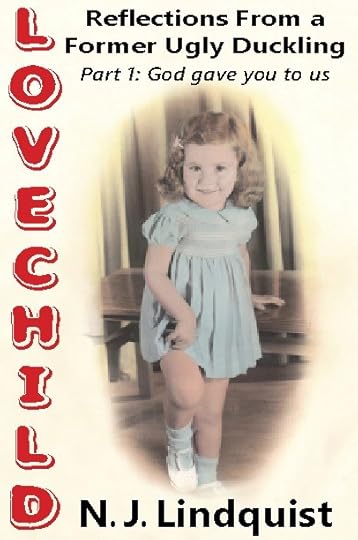
@media (min-width: 300px){.thrv_symbol_10531 [data-css="tve-u-1656479a734"] { width: 277px; float: none; margin-left: auto !important; margin-right: auto !important; margin-top: 0px !important; }.thrv_symbol_10531 [data-css="tve-u-1656479a731"] { margin-left: 9px !important; }.thrv_symbol_10531 [data-css="tve-u-1656479a730"] { max-width: 57.4%; }.thrv_symbol_10531 [data-css="tve-u-1656479a733"] { max-width: 42.6%; }.thrv_symbol_10531 [data-css="tve-u-1656479a72f"] { max-width: 820px; float: none; width: 100%; margin-left: auto !important; margin-right: auto !important; }.thrv_symbol_10531 [data-css="tve-u-1656479a72e"] { min-height: 245px; }:not(#tve) .thrv_symbol_10677 [data-css="tve-u-1656479a734"] { width: 252px; }:not(#tve) .thrv_symbol_10677 [data-css="tve-u-1656d159d04"] { font-size: 18px !important; }:not(#tve) .thrv_symbol_10677 [data-css="tve-u-1656d159d06"] { font-size: 18px !important; }:not(#tve) .thrv_symbol_10677 [data-css="tve-u-1656d15d51d"] { max-width: 679px; float: none; width: 100%; margin-left: auto !important; margin-right: auto !important; }:not(#tve) .thrv_symbol_10677 [data-css="tve-u-1656d15d51d"] > .tve-cb { justify-content: center; display: flex; flex-direction: column; }:not(#tve) .thrv_symbol_10677 [data-css="tve-u-1656d16fbe9"] { float: none; width: 100%; margin-left: auto !important; margin-right: auto !important; }:not(#tve) .thrv_symbol_10677 [data-css="tve-u-1656d1795e1"] { font-size: 18px !important; line-height: 0.35em !important; }:not(#tve) .thrv_symbol_10677 [data-css="tve-u-1656d17bf7c"] { line-height: 0.6em !important; color: rgb(113, 30, 30) !important; }:not(#tve) .thrv_symbol_10677 [data-css="tve-u-165876ba63a"] button { background-image: none !important; background-color: rgb(113, 30, 30) !important; }.thrv_symbol_10677 [data-css="tve-u-165876ba639"] { max-width: 515px; float: none; margin-left: auto !important; margin-right: auto !important; }:not(#tve) .thrv_symbol_10677 [data-css="tve-u-16587b55abb"] { font-size: 22px !important; }}
Have my new posts sent directly to your inbox.
Sign Up to Have All My New Posts Sent to Your Inbox
The post LoveChild 15: My Father’s Parents, George and Jennie Shaw appeared first on N. J. Lindquist.
October 16, 2019
LoveChild 14b: Our Sherritt / Baird Heritage Pt. 2
“No journey is too great if you find what you seek.” Anonymous In my last post, which was primarily about our Sherritt ancestors, I mentioned that George Sherritt married Sarah Jane Baird in 1873. Side Note - In case, like me, you're wondering why so many first names are repeated, not only from one generation […]
The post LoveChild 14b: Our Sherritt / Baird Heritage Pt. 2 appeared first on N. J. Lindquist.
Alternatives to Abortion – Or How To Be Pro-life and Not Merely Pro-Birth
20 things we could do to educate young people on how to prevent unwanted pregnancies and to help girls and women feel they have enough support to carry on with their pregnancies.
The post Alternatives to Abortion – Or How To Be Pro-life and Not Merely Pro-Birth appeared first on N. J. Lindquist.
October 15, 2019
Can You Be Both Pro-Life and Pro-Choice?
Abortion is a consequence of a society that doesn't provide adequate care for its women and mothers.
The post Can You Be Both Pro-Life and Pro-Choice? appeared first on N. J. Lindquist.



